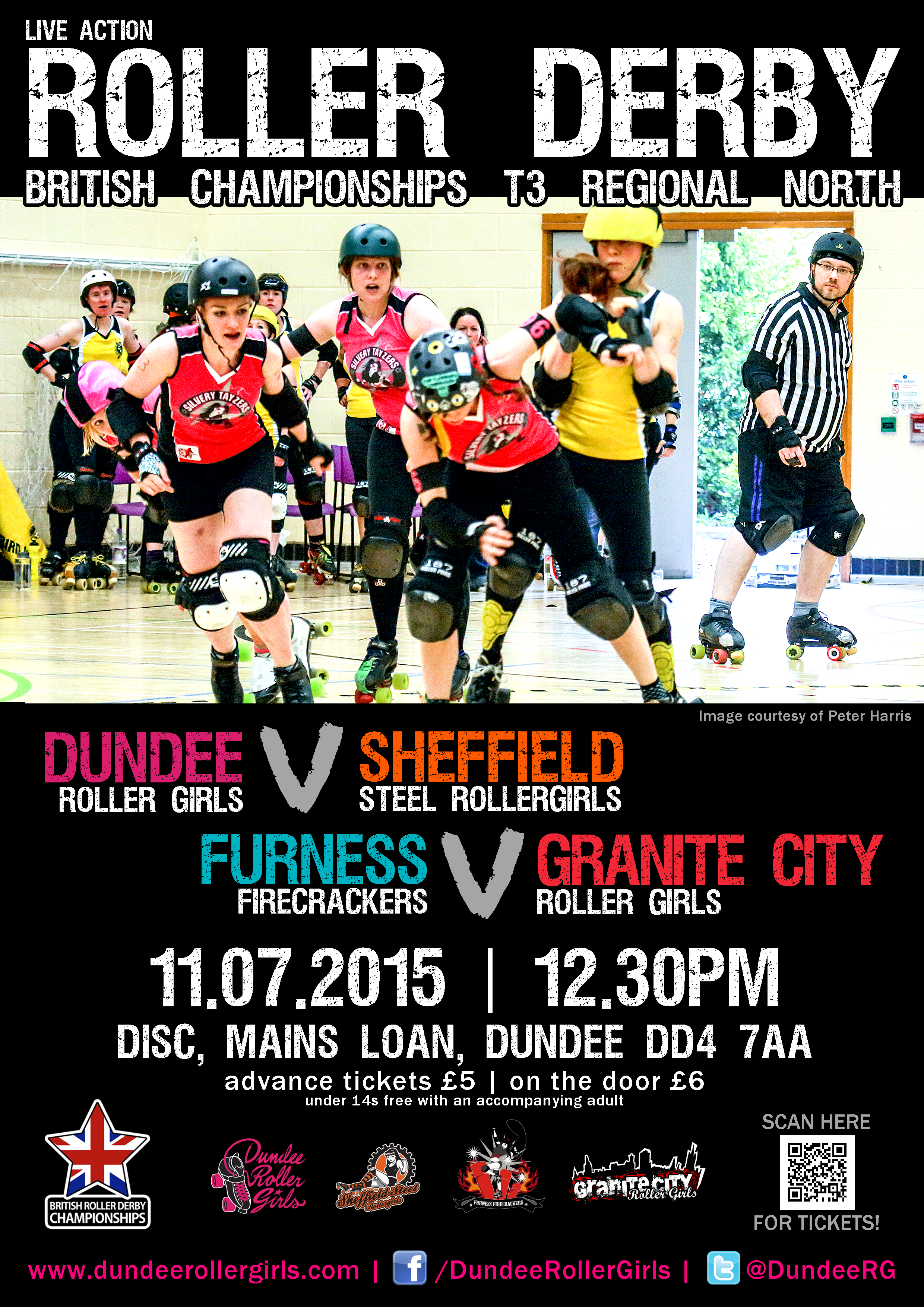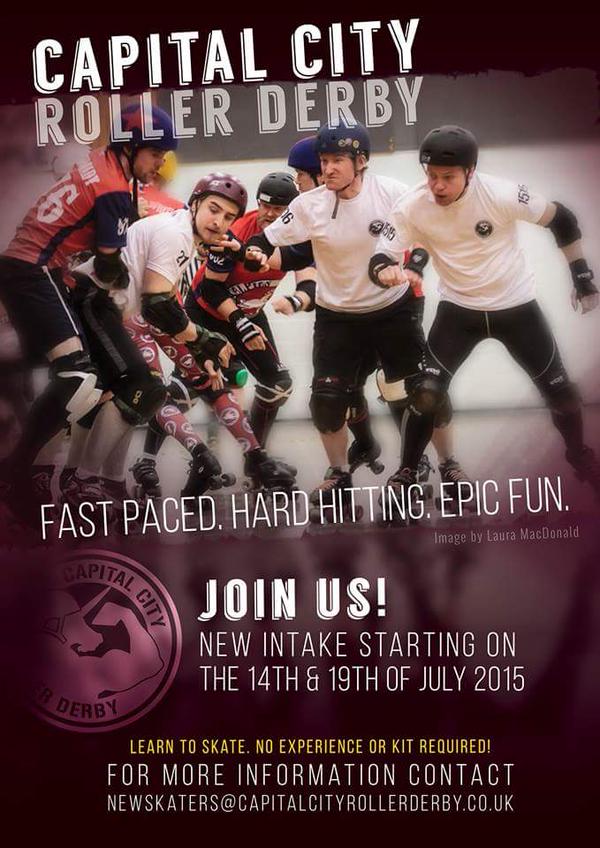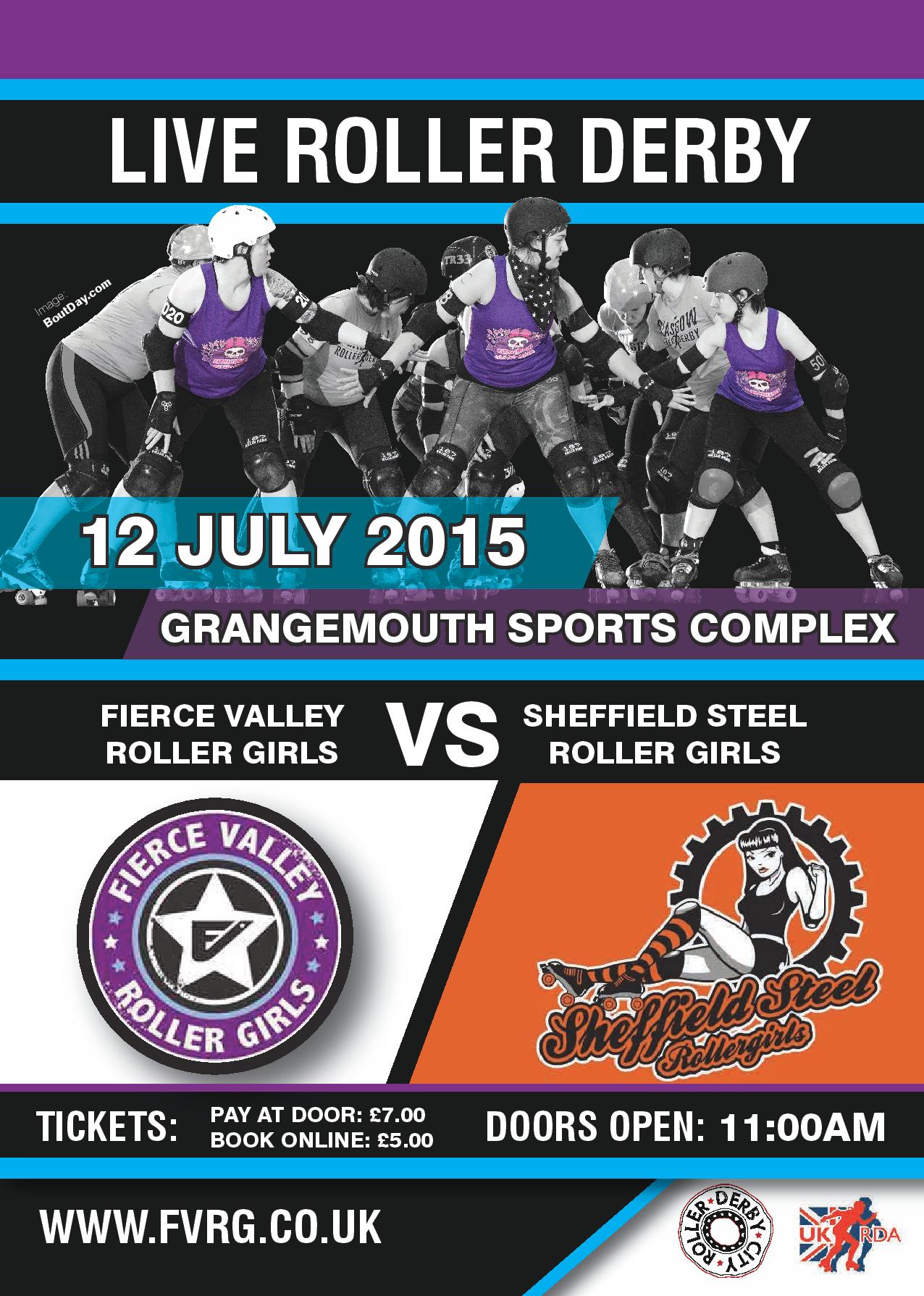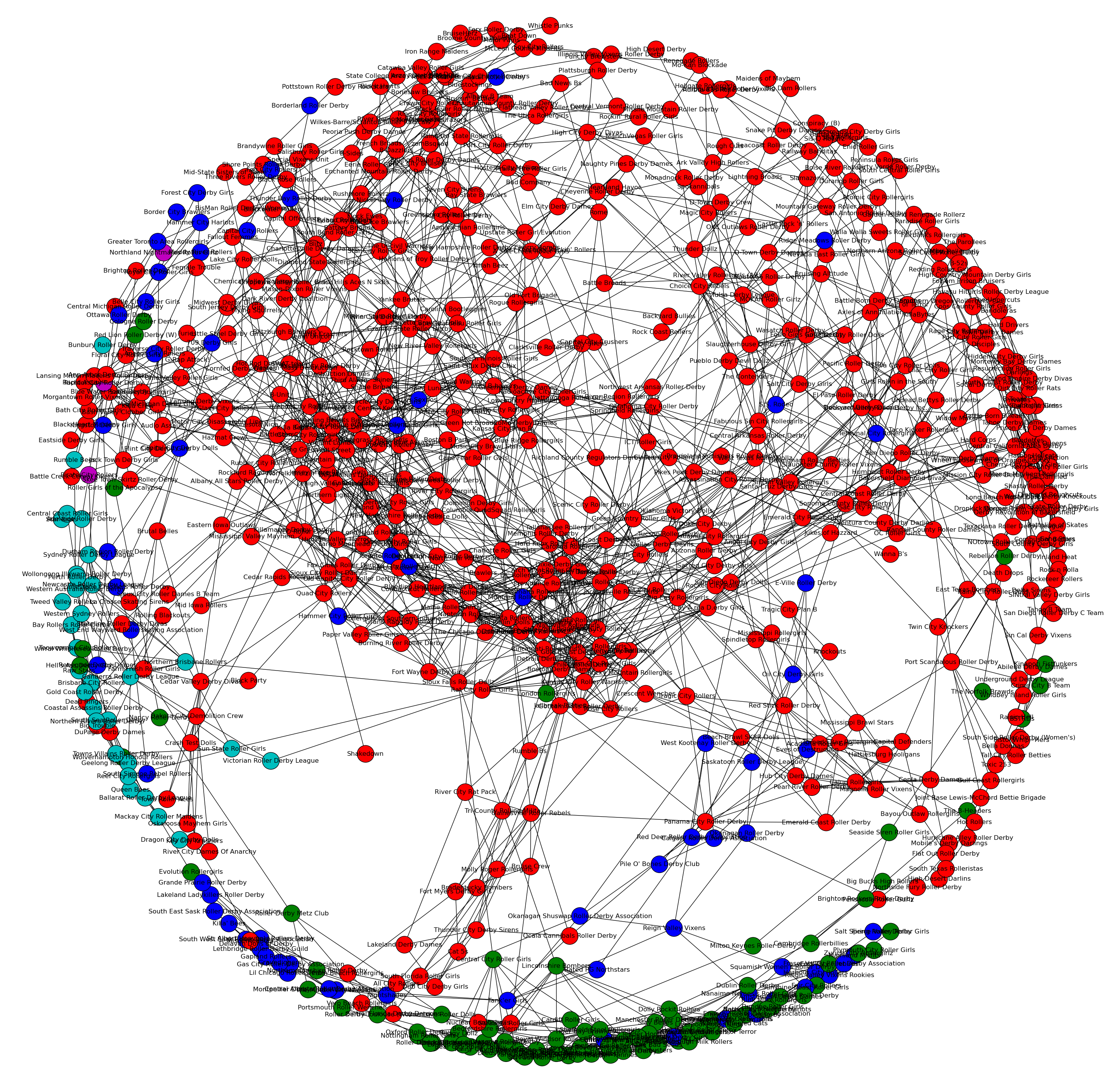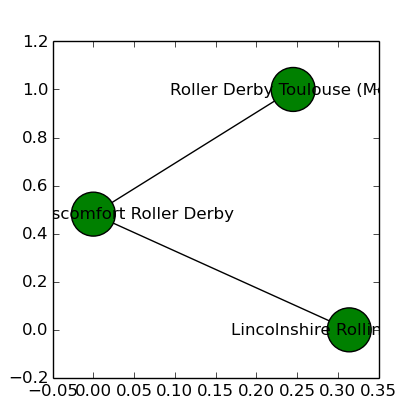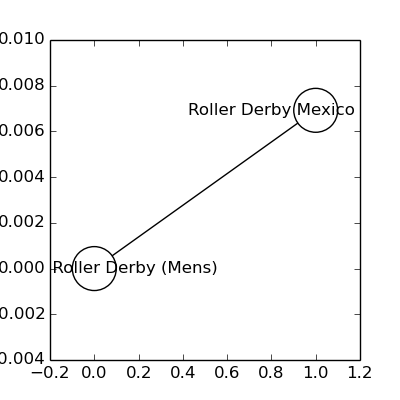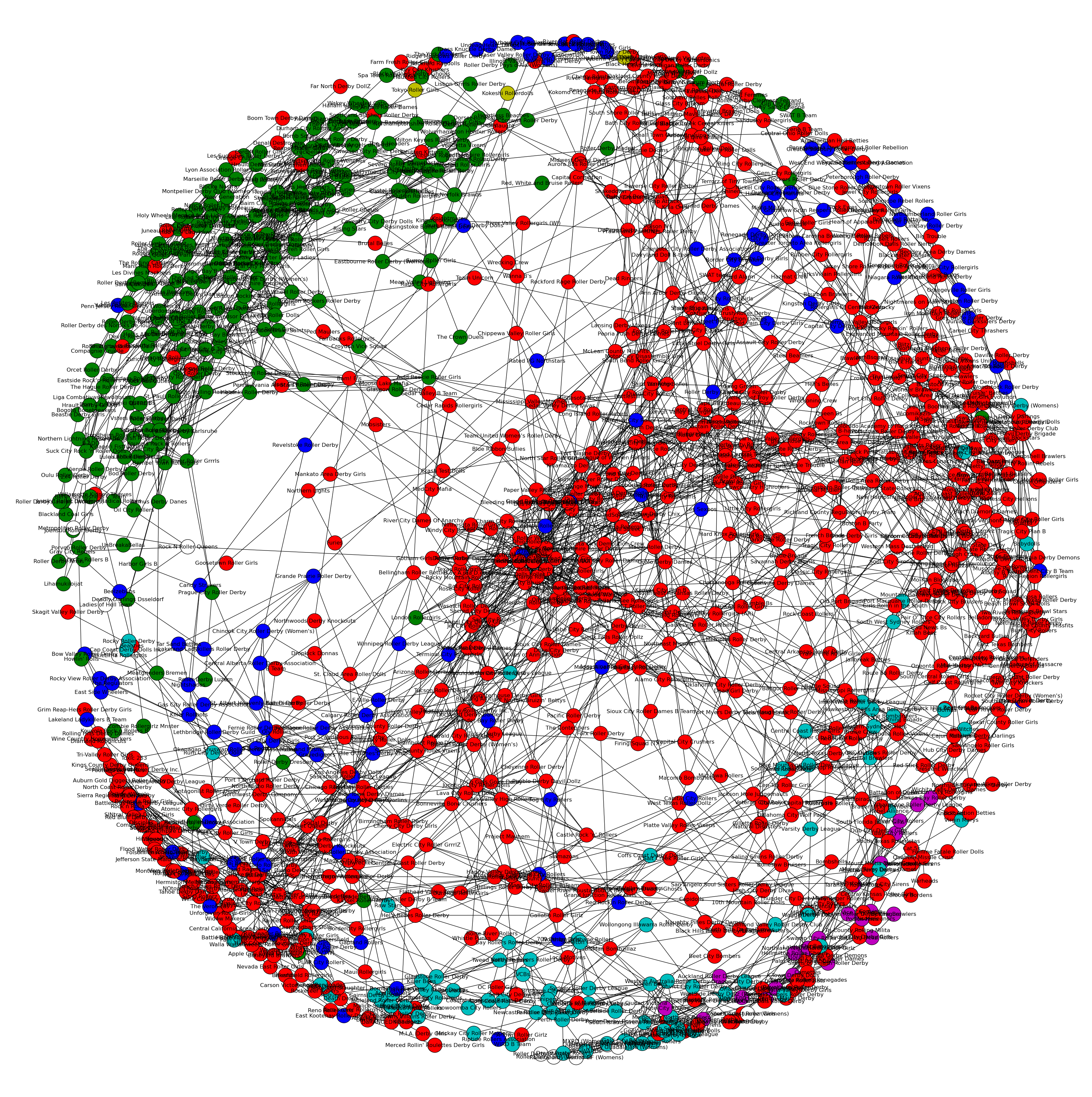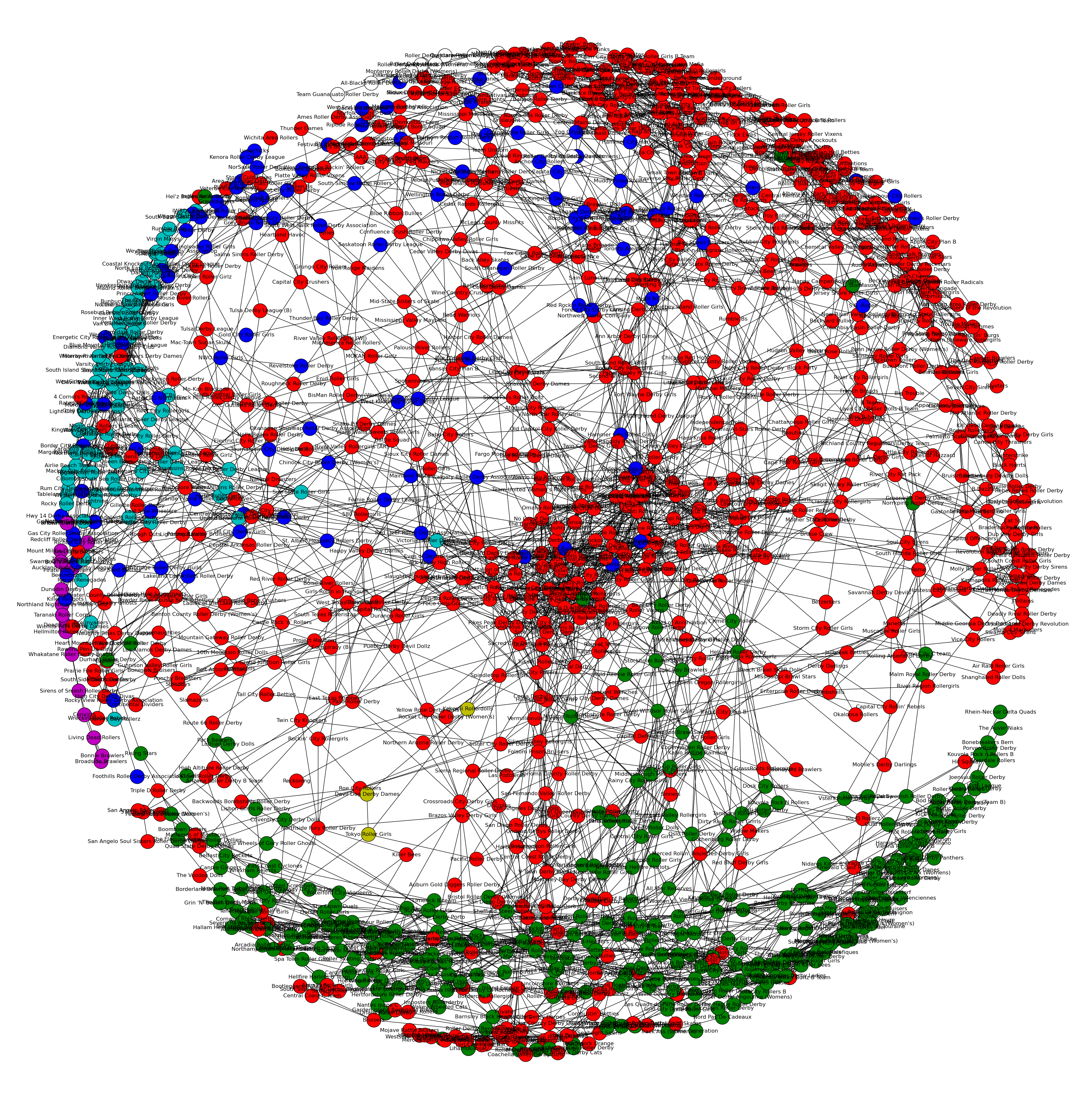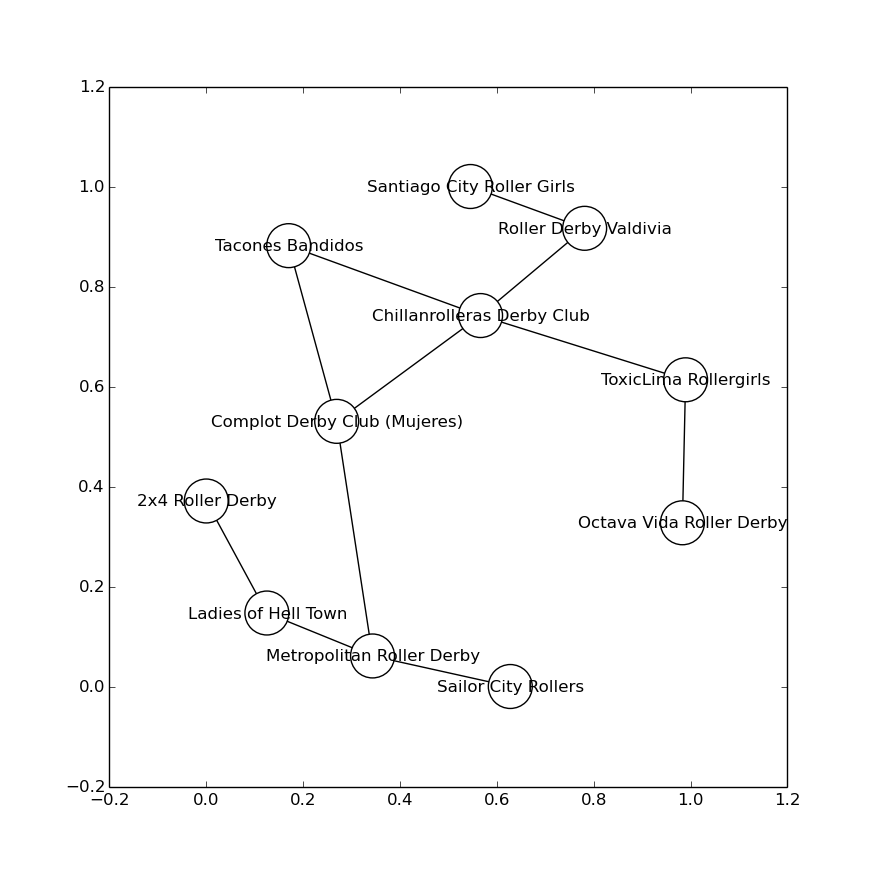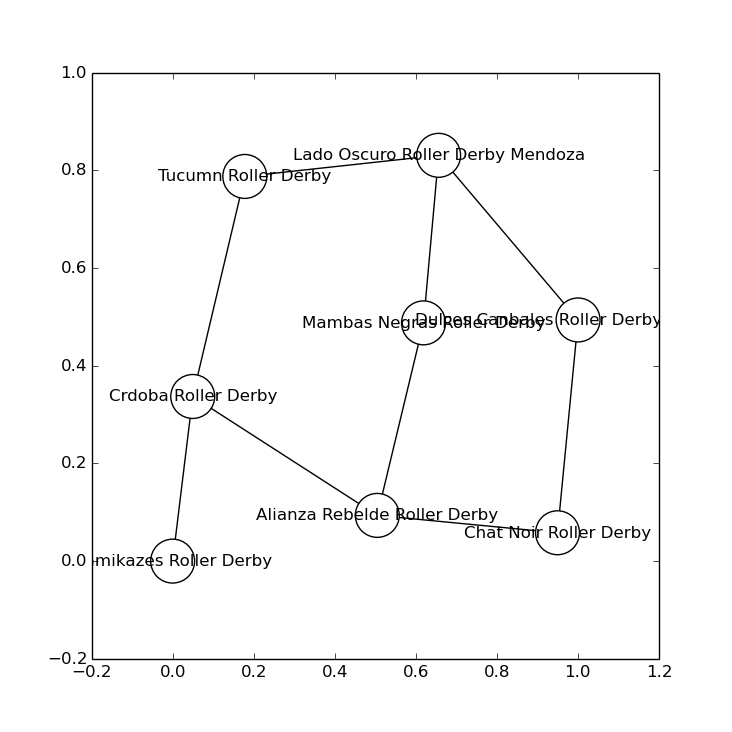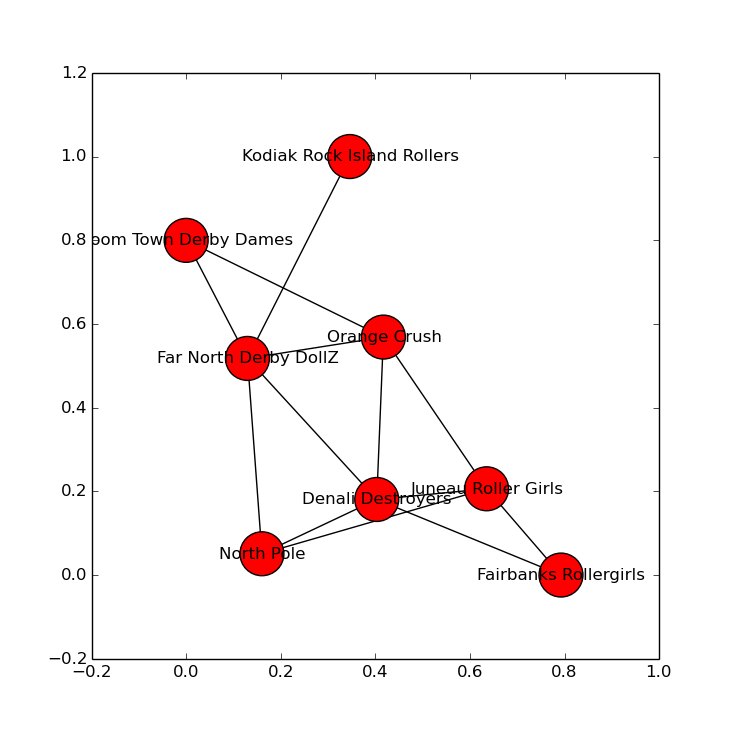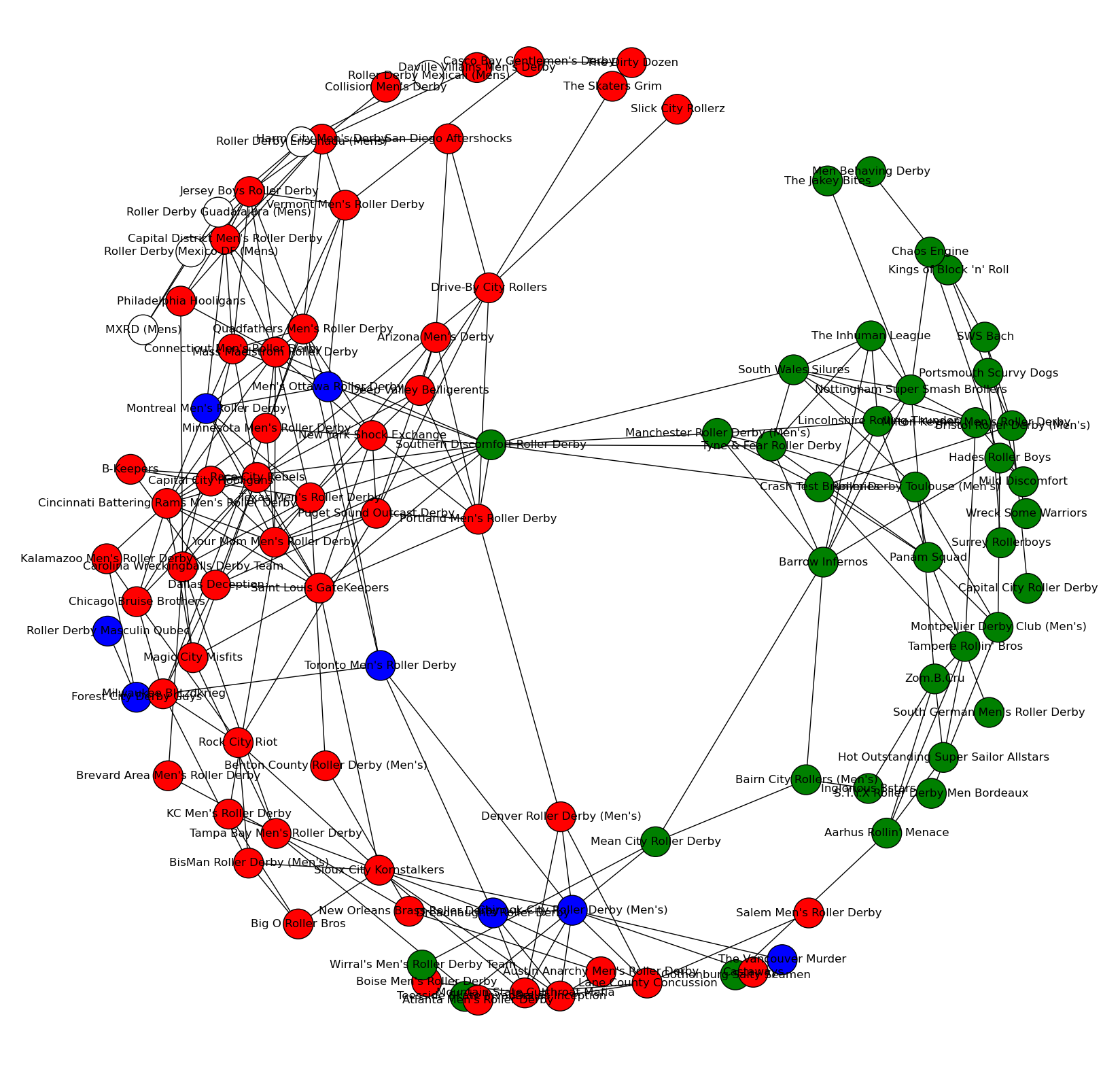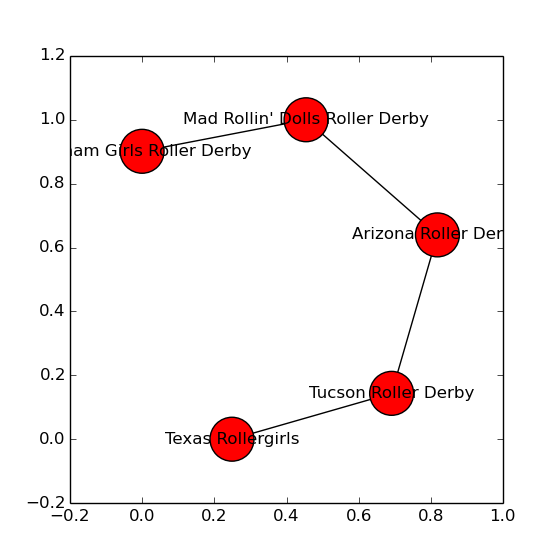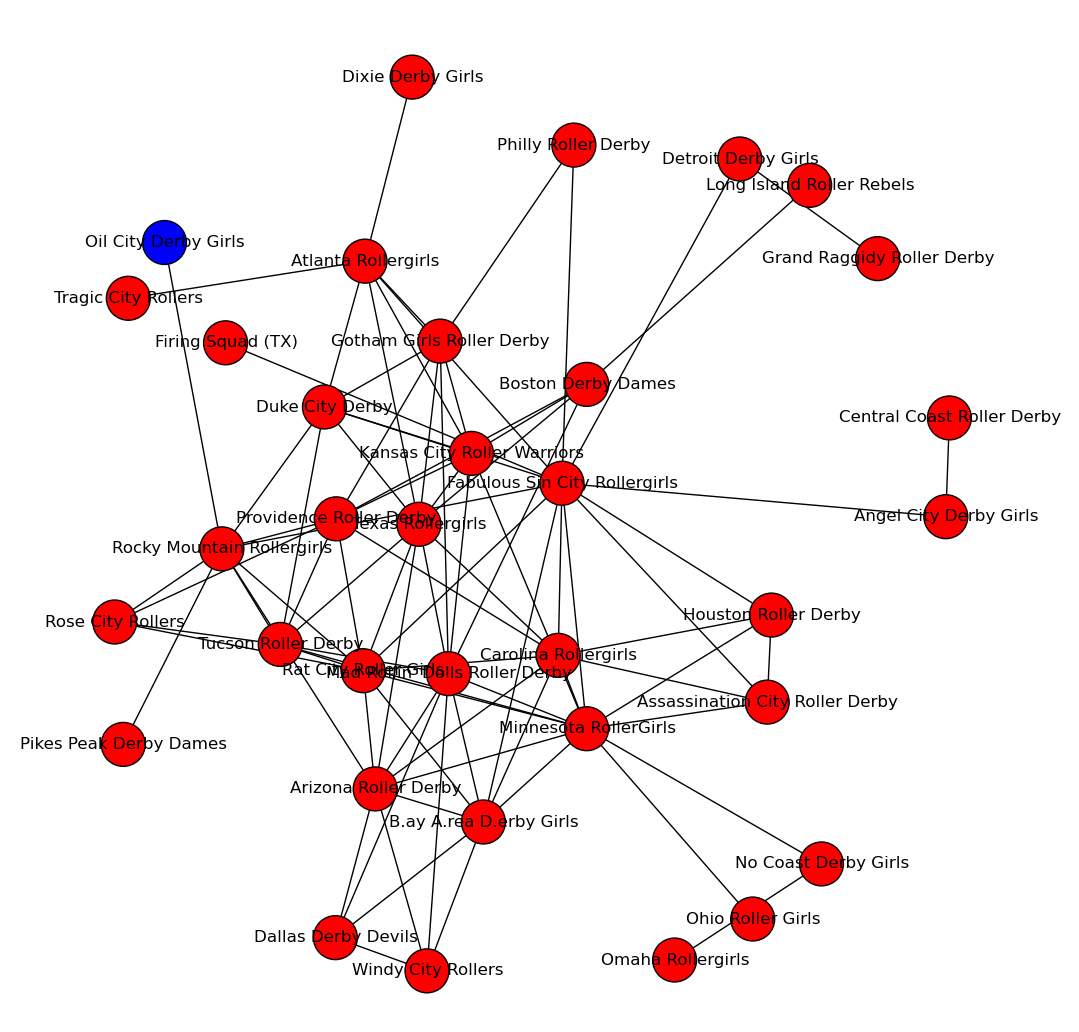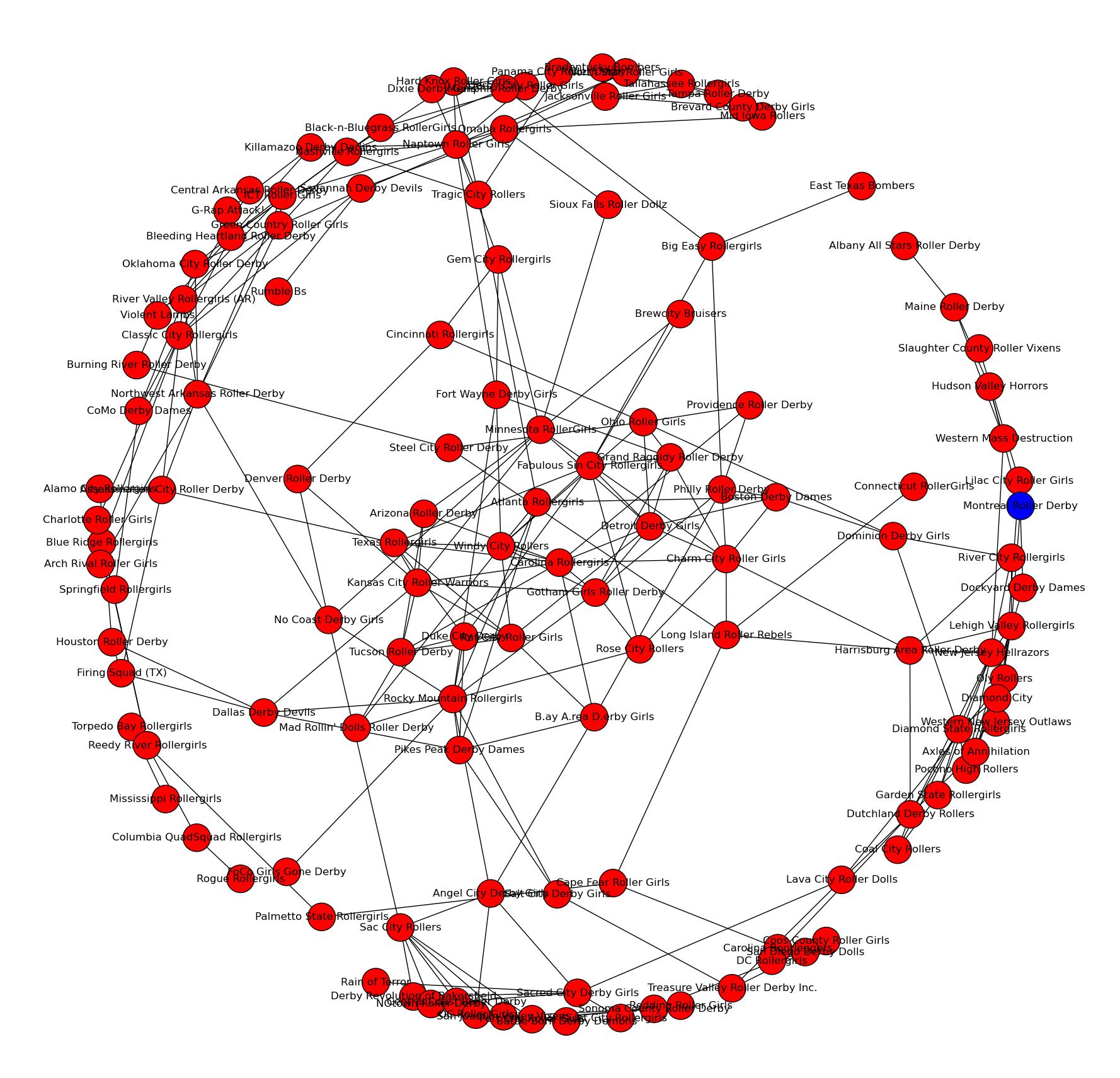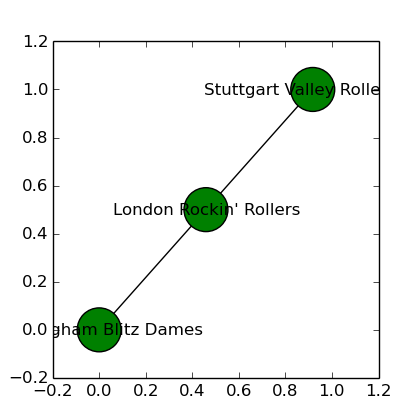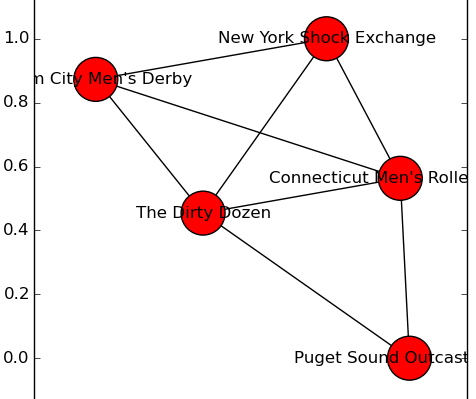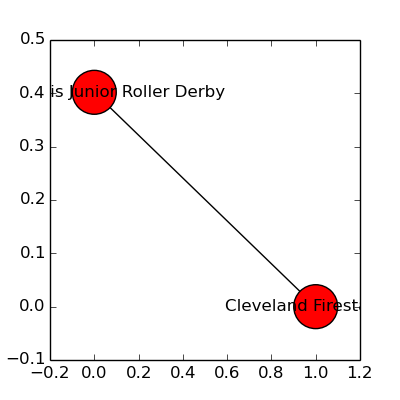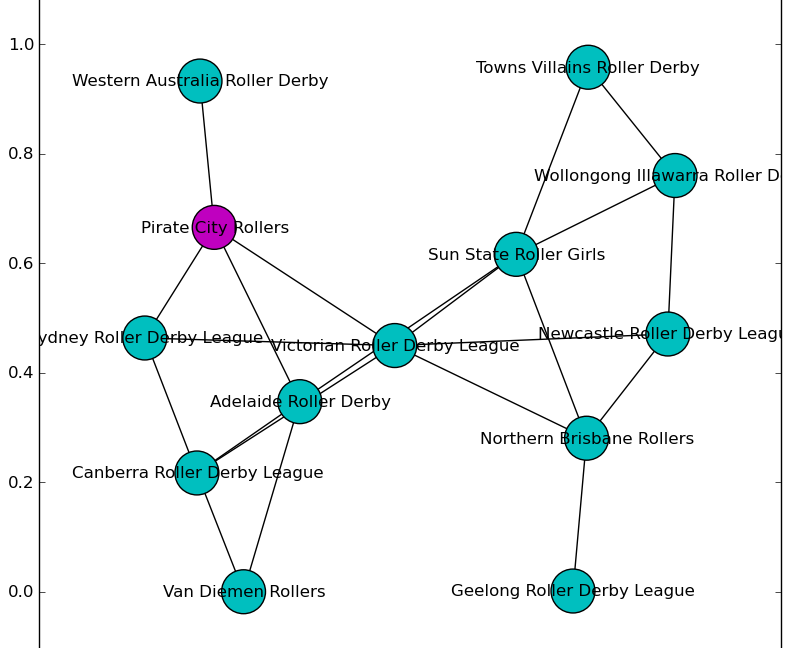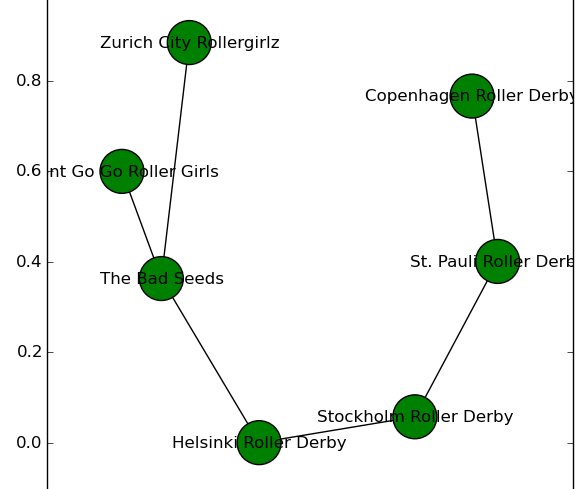Dundee Roller Girls British Champs Game Four
Dundee Roller Girls Silvery Tayzers host their first, long awaited home game of the season on July 11th at Dundee International Sports Centre. This game sees the Tayzers take on Sheffield Steel Rollergirls (featuring ex-DRG alumni Carnage T800), in Game four of DRG’s British Championships season. With both teams sitting on six points and with 2 wins and 1 defeat under their belt this is a must-win game for the Tayzers as their final game sees them take on league leaders Furness Firecrackers in a triple header in August. The game at DISC is a double header with Granite City Roller Girls taking on Furness Firecrackers, giving DRG an insight into what’s in store for their final game.
Doors open at 12.30pm, first whistle at 1pm. Advance tickets £5 available from here, tickets available on the door £6.
Join the Facebook event using this link.
Capital City's First 2015 new skater intake
Capital City are on the look out for new members and are holding their first 2015 taster session for new skaters this month. The taster session is open to all men over the age of 18 looking to try out roller derby no experience or kit is needed as they will help to provide this for the taster session. There are two dates available for people to sign up for, which can be done via their website. The taster sessions will be held on Tuesday the 14th and Sunday the 19th of July at their current training venue.
If you are interested head over to their website to find out more or sign up via their online form.
Fierce Valley Roller Girls vs Sheffield Steel Roller Girls
On Sunday 12th July, Fierce Valley Roller Girls will host their second home game of the year when the Parma Violents take on Sheffield Steel Roller Girls at Grangemouth Sports Complex. This will be the second half of a Scottish roller derby double header for Sheffield, after they face Dundee Rollers Girls in a British Championships T3 North game the previous day.
The Parma Violents have won both of their games this year, away to Birmingham Blitz Dames’ Bomb Squad and at home to The Darksiders in a Champs challenge game. If Flat Track Stats’ European rankings are anything to go by, this is bound to be a close game: SSRG are currently ranked at 75, with FVRG just one place behind at 76.
Doors open at 11:00 for the first whistle at 11:30. Tickets are available in advance here for the discounted price of £5 (+ booking fee), or £7 on the door. Join the Facebook event here.
A wee chat with Wee County Roller Derby
While established teams like Auld Reekie and Glasgow Roller Derby are now mature enough to be heading off to the USA, there are also new leagues just starting up in Scotland as well. We hope to cover a little more about Scotland's newest leagues in the near future, starting with the latest addition to the sport: Clackmannanshire's Wee County Roller Derby. We talked to co-founder Melissa 'Rammy' Russell about their story since the launch in May this year.
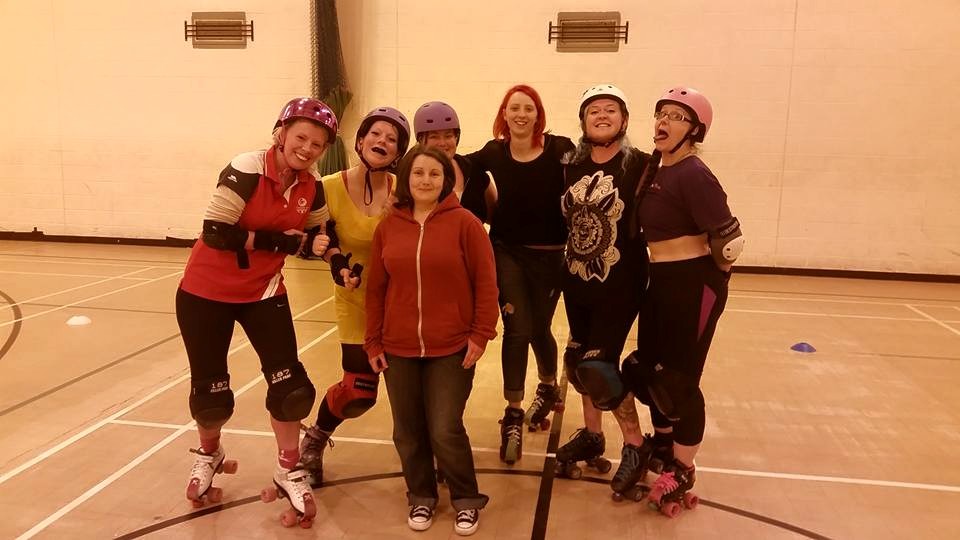 Wee County's first crop of newbie skaters (Rammy 3rd from right), with Voodoo's Roll-n-Pin 2nd-from-right along visiting the open session.
Wee County's first crop of newbie skaters (Rammy 3rd from right), with Voodoo's Roll-n-Pin 2nd-from-right along visiting the open session.
The appearance of Wee County Roller Derby earlier this year came as something of a surprise to most of us. To start off, can you tell us a little about yourselves, and why you founded a new league?
WeeCRD started as a little random thought bubble between myself and our other founding member as we found ourselves looking for a new team to join. There was almost too much choice in Falkirk, if that makes sense? DreadKnot is actually based in Alloa and we realised that no one else was training or representing the Wee County. A lightbulb went off in our heads immediately and we toyed with the idea of starting a Clackmannanshire based team for several months before we realised that we could actually make this dream a reality. Almost four months later and here we are!
Co-ed Derby is more popular than it used to be, but it’s far less widespread even than men’s derby, let alone women’s. Why did you choose to be a co-ed league? Are you planning on having only a co-ed roster, or also producing women’s or men’s rosters to get more bouts in (given the limited availability of co-ed teams at present)?
We chose to identify as a co-ed training team simply because we want to give everyone regardless of gender the opportunity to play roller derby. We are planning to have a co-ed roster, a men’s and a women’s roster also so that we give ourselves the option for more bouts.
The area around Stirling and Falkirk has the highest density of roller derby activity in Scotland - three women’s teams, two men’s teams, two co-ed teams and the only bouting junior derby league in Scotland in Fierce Valley Roller Cubs. Do you think that there’s something special about the area that encourages so many teams to co-exist?
We love that there are so many teams in the Forth Valley area, it means that our little community is even tighter and more connected than in other areas. There is definitely something in the water round here that makes people connect with Roller Derby on a scale unlike anywhere else we’ve seen.
Given the already packed roster in the area, are you concerned at all about competition for skaters from the more established teams?
We aren’t concerned about competition at all as we consider ourselves to be a purely Clackmannanshire based team. There are a lot of people who struggle to find time and money to be able to travel to Falkirk to train with the teams through there, whereas in the Wee County we are situated nicely for anyone in the area as well as anyone in Stirling and beyond.
Recruitment has been a gradual process so far. As we are working towards being able to host a mass recruitment we are bringing in skaters one or two at a time and so far our retention rate has been pretty high. We now have seven skaters, two of whom are fresh meat which is exciting because we get to start from the ground up to get everyone minimum skills past. Because of our connections and the nature of roller derby being such a female dominated sport we do have only female skaters at the moment. However, we do have a couple of guys trying out in the next few weeks so slowly but surely we are working to break down that gender barrier and make everyone feel welcome.
As with Fierce Valley, you seem to have been successful at getting mentions in the Alloa Advertiser, have you noticed an improved response from traditional media coverage?
The article in the Alloa Advertiser went out last week and since then we have had a lot more interest in the team on a local scale as well as giving us credibility within the roller derby community. I think some teams play it safe by sticking to just digital marketing, but with an area like Clackmannanshire it’s essential that we utilise traditional media in the same respect.
We also see you have your first fundraiser (an Acoustic Night at Peppes Bar, Alloa on the 24th of July) planned. Can you tell us a little about the line-up arranged, and where the funds will be going?
We are incredibly excited about this as it will mean that we can not only raise funds but get our name out to the local area as well. As for the line-up on the night, announcements will be made on the Wee County Roller Derby event page this week so keep an eye out!
Funds will be going towards building our fresh meat kit so that we can host mass recruitments as well as ensure that we can increase training time for the team and potentially pay for further media coverage so that we can increase awareness of Clackmannanshire’s first ever roller derby team.
Finally, can you tell us a little about your plans for the coming year?
Our main objective for the next twelve months is to get our skaters through their minimum skills as well as to be able to recruit on a larger scale so that we have a full roster to play our debut game before the year is out.
We don’t want to rush the training process just so that we can get a game done. Our main priority is to make sure everyone is the best skater they can be and feel ready to bout.
There will no doubt be more fundraisers throughout the year and perhaps some charity scrimmaging but all will be confirmed later in the year.
We will also be launching our brand new logo this month!
So….look aboot ye ;)
WeeCounty Roller Derby can be found on Facebook, Twitter and Instagram, and using the #lookabootye tag.
Drawing inspiration for Power of Scotland
From Caledonian skulls and Claymores to Highland cows and Nessie on skates – the race to design the new logo for Scotland’s men’s roller derby team has been a runaway success.
A plethora of prospective logos were submitted for the contest to help brand Power of Scotland’s push towards Men’s Roller Derby World Cup in Canada next year.
All of the entries were put to the vote and two have emerged as clear favourites, with the margin separating them closer than a sudden-death jam between Gotham and Rose City.
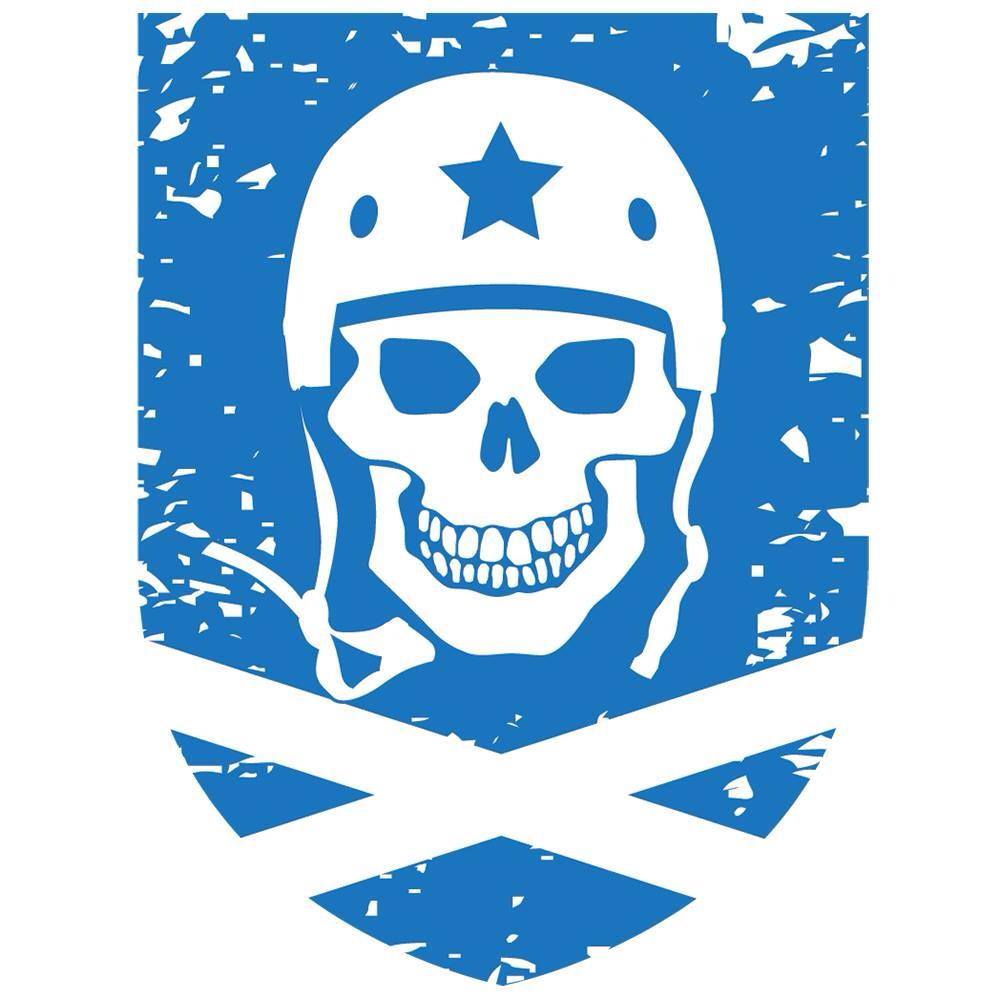 The current Power of Scotland logo
The current Power of Scotland logo
In fact, they are so close that the PoS management team has decided to seek expert advice to help ensure Scotland has the perfect logo to rock the world in Calgary.
The aim is to ask a professional designer to look at the two logos which proved the most popular.
Manager Nikki Morris said: “We can't wait to publically unveil our logo, but we want to take this extra time to ensure it’s as amazing as the skaters who are going to proudly wear it on their chests.
“All of the designs received were excellent and the feedback from skaters and fans has been amazing. The vote was incredibly close between the two most popular designs so we thought in the interests of fairness we should ask a professional to have the casting vote.
“Our hope is that the chosen design will be refined and posted as soon as it’s finalised.
“We would like – once again – to thank everyone who took the time to contribute their ideas and to vote for their favourite.
“The passion and creativity shown by everyone who supports Power of Scotland is a genuine inspiration for everyone associated with the team.”
Meanwhile, the PoS training squad was recently announced, with 30 skaters involved from all over the British Isles.
Head Coach Hannah Grant (aka Ginge) said: “We held two try-outs and the attendance for both was incredible, with all the skaters involved giving everything they had in pursuit of their Power of Scotland dream.
“Narrowing it down to just 30 was extremely difficult and one of the hardest things I have personally been involved in as regards derby.
“However, after a lot of hard work we have been able to announce the squad … and now the hard work really begins.
“As well as training with their own leagues, our skaters will train together once a month and scrimmage until October.
“The selection committee will then come together again to watch a Scotland vs Scotland game made up of the training squad. From here the 20-man squad for Calgary will be selected and will go on to train till the World Cup.
“The coaches can’t wait to work with this fantastic group of skaters – we’re determined to show the derby world what Scotland has to offer.”
Visit www.facebook.com/PowerOfScotland for more information on how you can help the team on its journey to the World Cup.
Glasgow Roller Derby - British Champions
GRD’s all-star team won the inaugural British Roller Derby Championships – with emphatic wins over teams from Edinburgh, Cardiff, Manchester, Birmingham and Middlesbrough.
The competition culminated in a two-day derby extravaganza – held in Glasgow – on May 30 and 31.
Hundreds of fans crowded into the ARC sports centre to cheer on their heroes and were treated to an amazing display of sporting prowess, skating skills and blistering action.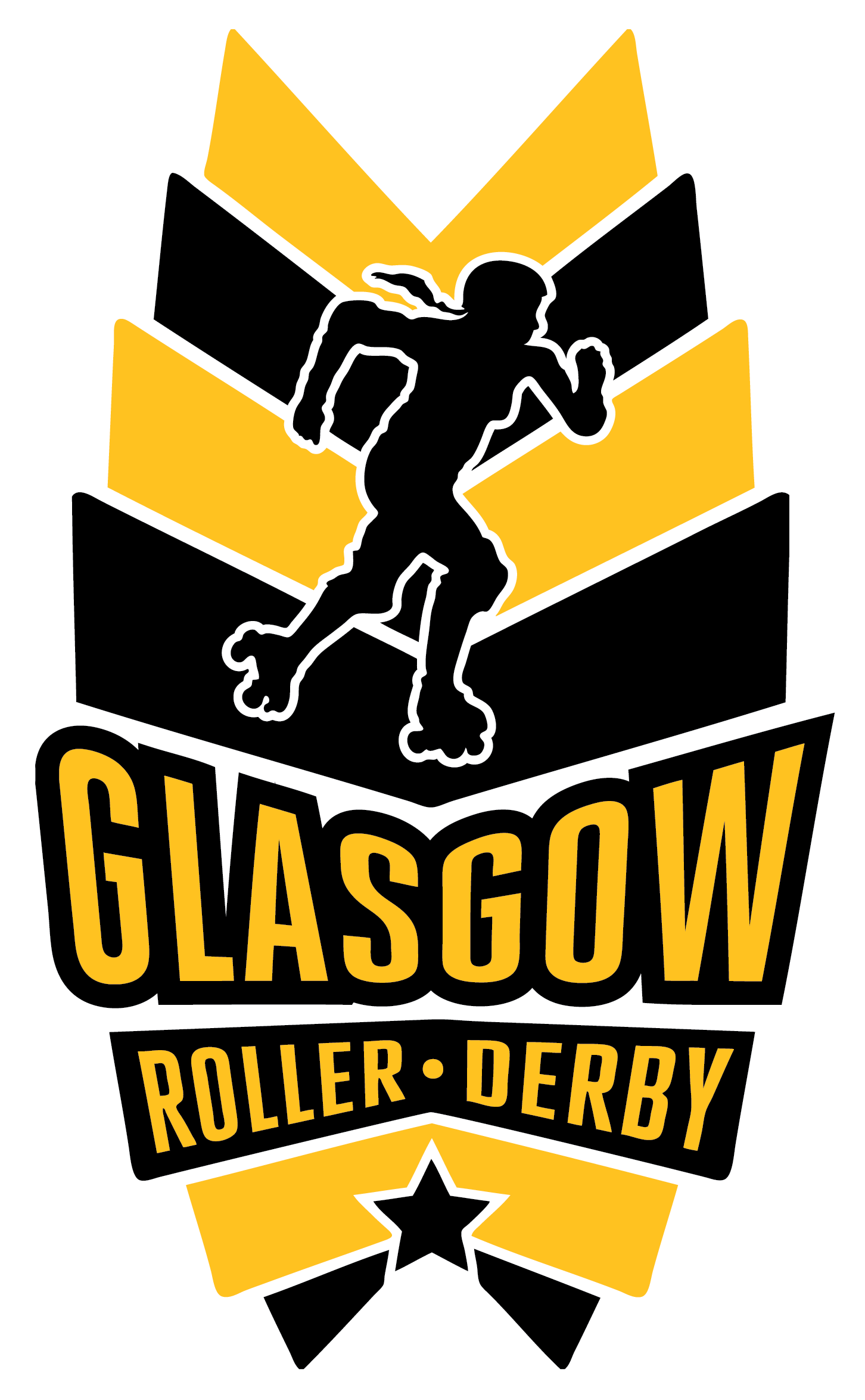
Tribute has been paid to the all-female Glasgow league for flying the flag for Scottish sport – continuing the legacy of sporting achievement which put the city on the world’s centre stage during the Commonwealth Games.
Glasgow Roller Derby are first in the UK Roller Derby Association rankings and second in Europe (outside of London Rollergirls) – a remarkable achievement for Scotland’s first roller derby league, started by the skaters themselves in 2007.
GRD co-captain Grace Maclean – aka Mona Rampage - said: “I am so proud of my league and my team. We went unbeaten throughout the British Championships – winning all five of our games against the cream of the crop in UK roller derby.
“To lift the trophy with my friends and league-mates was something I will never forget. We’ve worked so hard as a team and an organisation – it genuinely means a lot for us, our friends and our fans.
“Winning the championship is the culmination of months of hard work from everyone involved with GRD. I hope we’ve done Scotland proud and that everyone can draw inspiration from what we’ve achieved together.”
This is the first year of the British Roller Derby Championships – which featured four tiers of female teams, comprising 13 divisions. There were also three tiers for male teams.
Glasgow was in the top tier – alongside elite teams such as Auld Reekie Roller Girls from Edinburgh, Middlesbrough Milk Rollers, Tiger Bay Brawlers from Cardiff, Birmingham’s Central City RollerGirls and Rainy City Roller Girls from Oldham.
Glasgow went into the final weekend at the top of the table, with three wins from three games – knowing two wins would secure the inaugural trophy.
Meanwhile, the leagues at the other end of the table were fighting to avoid the drop into the second tier – with two teams destined to be relegated.
That set the scene for a pulsating weekend of derby action – featuring thrills, spills and more than a few skills from all the skaters involved.
Thanks have been given to Glasgow Sport for its support towards the staging of the event, as well as everyone at the British Champs, UK Roller Derby Association and Derby Duck Productions.Saturday saw Central City RollerGirls (CCR) narrowly defeat Rainy City (RCRG) 129-124 in a fantastic opening game, with both teams desperate to win in a bid to juke around relegation.
GRD then took to the ARC track knowing a win would put them within a toe-stop of the British Championship. In the end they won convincingly – beating Middlesbrough Milk Rollers (MMR) 205-119.
Auld Reekie Roller Girls (ARRG) and Tiger Bay Brawlers (TBB) supplied the action for the final game on Saturday, with the Edinburgh team taking the win and all three points to remain second.
Into Sunday and GRD had an early start against Rainy City. But any hopes that the Gallus Glaswegians would be caught napping were quickly put to bed as the all-stars won 227-131.
Game two then served up a cracking, evenly-matched contest as Tiger Bay took on Middlesbrough. Potentially both teams had a chance of snatching second – although a massive points swing would have been needed.
It was a nail-biter the whole way – with the lead changing hands repeatedly as both teams competed brilliantly on the track. It seemed MMR had edged it in the final seconds with a dramatic 164-163 win, but a point had been missed and the readjusted final score was 164-164 – meaning the contest had to go to an overtime jam to decide the winner.
Everyone watching in the hall – and around the world via the live stream – were then treated to two minutes of action they would never forget. Both teams scored in the breathtaking final jam, but MMR edged it – just - 183-178.
That put MMR on nine points – equal with Auld Reekie, but behind on points scored and conceded. The Edinburgh team then consolidated their second-place position against CCR, winning 168-152 in another closely-fought contest that went the full distance.
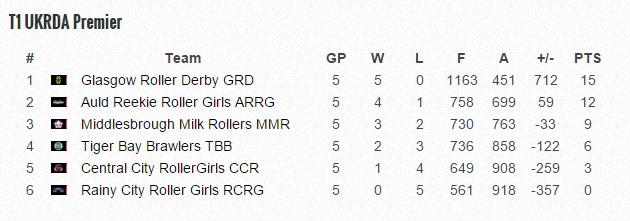
“The games were also broadcast live on the Internet and watched across the world, so it genuinely was a team effort from everyone involved.
“I want to say a massive thank-you to all who supported the event and helped to make it happen – especially the roller derby fans who provided such an amazing atmosphere.
“It was a genuine thrill to be involved and to host the final weekend of action in the first year of the competition. To win the trophy unbeaten is a fantastic achievement for everyone associated with Glasgow Roller Derby and we hope we’ve done our city – and our country – proud.”
The adventure doesn’t stop there for GRD. They hope to compete again in America soon – flying the flag for Scotland in the country where modern-day roller derby was born.
The meteoric rise of Glasgow is no fluke – it’s the culmination of years and years of training, practice scrims, skills sessions, endurance work and league organisation.
For more information on the league, visit www.glasgowrollerderby.com
Book Review: Derby Life by Em Dash
More than 9 months ago, Gotham Roller Girls' Margot "Em Dash" Atwell started a Kickstarter to crowd-fund a new book on Roller Derby. Her aim was to produce a new introductory book on the sport, showing a prospective new member of the derby community everything they needed to know to understand the culture and demands of Derby, and enthusing them about the sport.
Released to backers on the 17th June 2015, and preorderable from Gutpunch Press for nonbackers, Derby Life: A Crash Course in the Incredible Sport of Roller Derby is the result.
Inevitably, as a "Book for prospective new skaters", comparisons with 2011's Down and Derby will come up. And, yes, both books have a somewhat similar overarching structure - Down and Derby and Derby Life both start with a chapter on the history of the sport, going back to the original Walkathons in 1920s New York, and sections following on various aspects of derby culture (what kit you need, what the rules are, "Derby attitude"...). Of course, a lot has changed in roller derby culture over the last 4 years, and this is really key to the differences between the works - while Down and Derby projects the more actively Riot Grrl tone still around in 2011, and is innocently Americentric in its treatment of the sport, Derby Life is happier to emphasise the actual sporting and athletic aspects of the game, and tries to be less parochial in its conversation. For the most part, this is an improvement on the former book, although I did sometimes miss the punchier tone that the younger sport evoked.
If there are flaws in Derby Life as a book, they also stem from its determination to be even handed - a decision to try to make the book independent of any particular ruleset means that the rules discussion becomes a little too generic for my taste (and, yet, still mentions that the purpose of pivots is to take star passes, even though that isn't true in several of the rulesets that Em Dash mentions in the same chapter). The same problem occurs in the tactics/strategy section, presumably in an attempt to keep the text relevant in the face of a rapidly changing metagame. In general, I found that the best chapters were those which tried to actually give more detailed advice to the prospective skater: the gear, training and health/psychology sections were all very good.
All of this said, most of the Kickstarter backers are not the target audience of Derby Life. We are generally existing members of the derby community, and so introductory advice, as comprehensive as Em Dash makes it, is always going to feel a little lacking. For us, the crowning glory of Derby Life is right at the end: the collected selection of derby anecdotes, advice and expressive writing from individual skaters across the world. While they are extremely varied in length, style and content, each of them is a heartfelt gem, and as effective advocate for roller derby as the other 80% of the book.
Judged as a modern, comprehensive introductory guide to participation in Roller Derby as a sport, Derby Life is an excellent work, and you should feel no hesitation in getting a copy for any prospective skaters you know, especially if you were already thinking of buying them Down and Derby. More established members of the community, however, will still want to pick up a copy just for the collected Derby Stories section at the tail end of the book.
Visualising the Internationalisation of Roller Derby Part 2 of 2 (2011 to present).
In the first article in this series (link) we introduced the use of FlatTrackStats bout records to visualise the connections between derby teams over time. As with that article, this article is licensed Creative Commons: Attribution-NonCommercial-ShareAlike (you may reuse and share this article freely, as long as you attribute it to the author, do not profit from it, and license any derived work with the same license). This article was generated, as the previous one was, with data kindly provided by FlatTrackStats, licensed CC:BY-NC.
Previously, we covered the period in WFTDA, MRDA and Junior derby from the origins of organised derby in 2005 through to the emergence of junior derby, the men's game and the first truly international period of derby in 2010.
In this article, we will cover the period from 2011 to the start of 2015. As with the previous article, our colour coding scheme is: Red is USA, Blue is Canada, Green: Europe, Cyan: Australia, Purple: New Zealand, Yellow the Asia-Pacificc, and White: Latin America. Groups which are densely connected from playing lots of games together will group physically closer in the plots, while less connected groups are thrown out to the edges.
The success of London Rollergirls playing across in the USA in 2010 inspired other European teams to try the same thing a year later (bolstered by the first ever World Cup also being in that year). The largest connected group in 2011 looked like:
Compared to the 2010 plot, the additional European teams (Central City, the Lincolnshire Bombers et al) connecting with the USA pull the densely connected centre of the plot out somewhat, making it less insular. Conversely, London Rollergirls are pulled in the other direction - from this point on, their green dot is the one nestled in the core of the central, well-connected part of the plot, disconnected somewhat from the rest of Europe. We also see that Australasian derby has joined the International community proper, with Victorian Roller Derby League placing them in contact with the Americans.
Meanwhile, Latin America is showing the first signs of widespread derby growth, with a healthy crop of new leagues all playing each other:
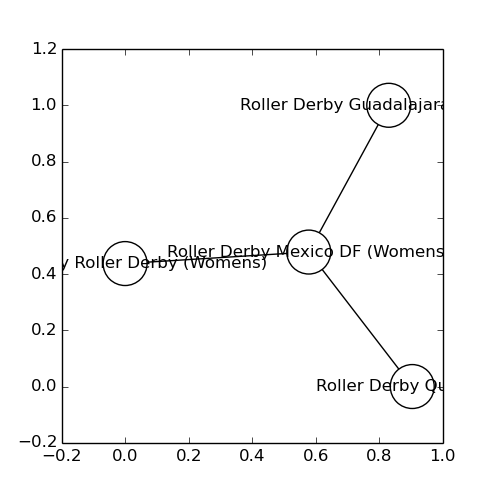
Men's derby, by contrast, is not yet fully international in 2011, with the biggest connected group resolutely USA and Canada:
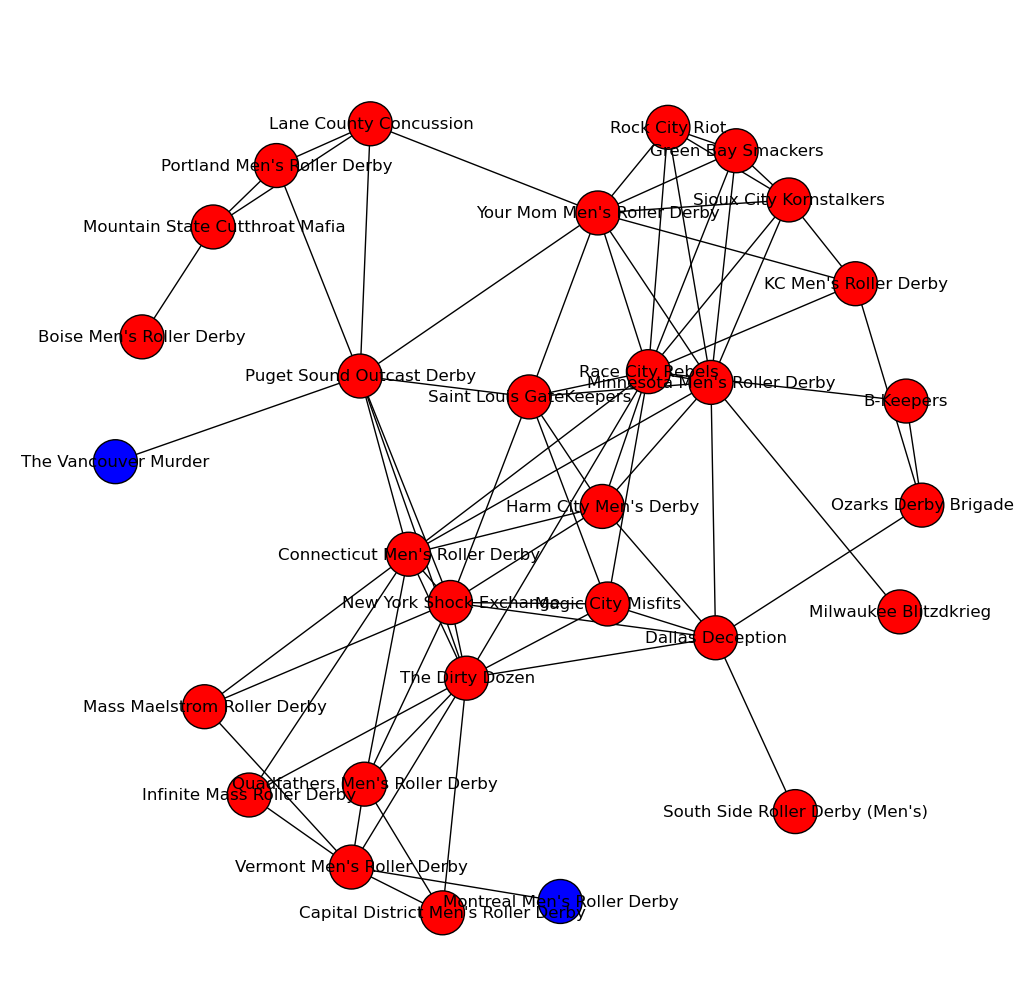 Although both Europe and Latin America are starting to show their own growth:
Although both Europe and Latin America are starting to show their own growth:
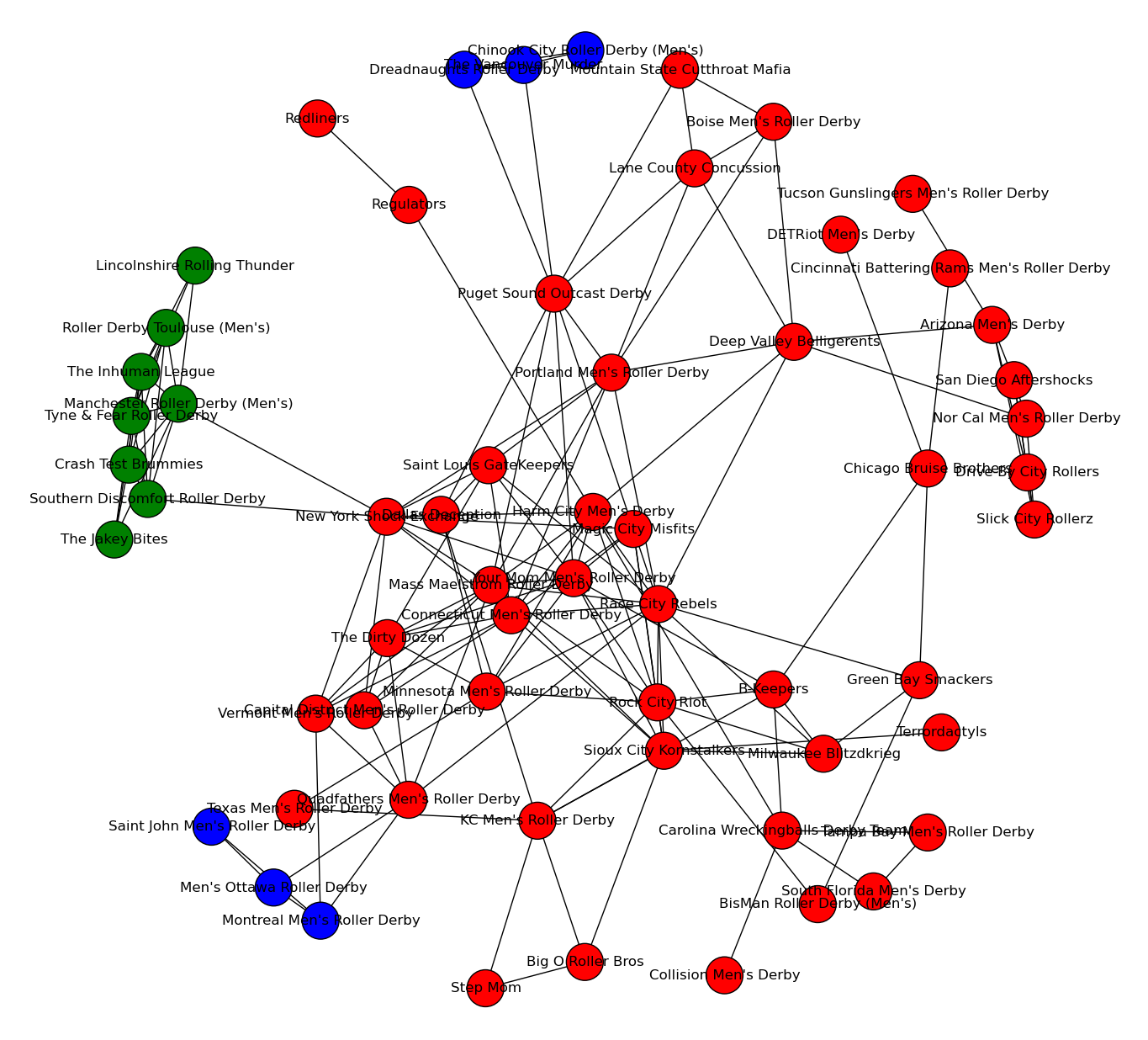 and not until 2013 that Latin America joined the biggest group:
and not until 2013 that Latin America joined the biggest group:
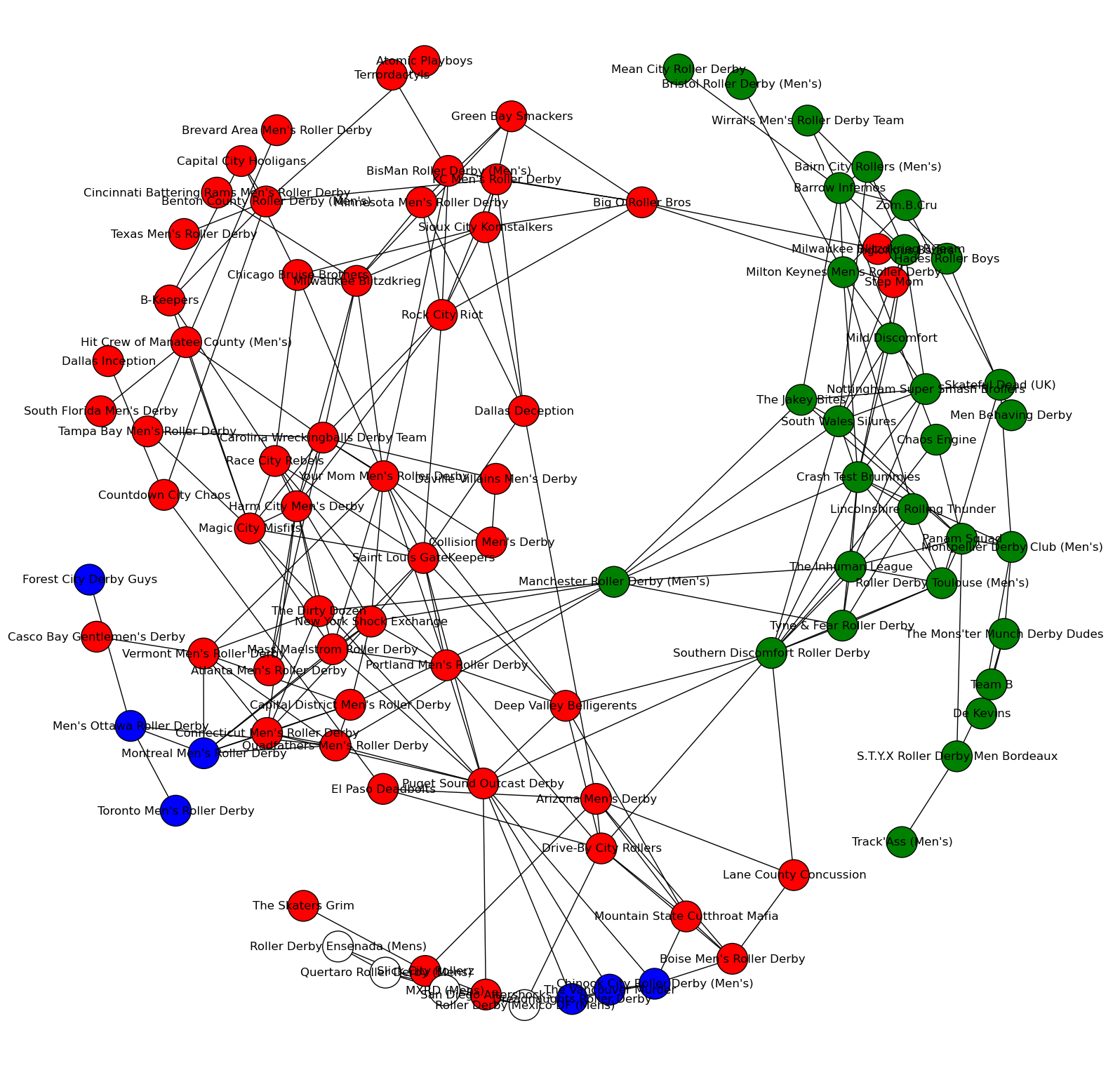 just in time for Men's Derby to properly take off in Australia (now the largest group separate from the main one):
just in time for Men's Derby to properly take off in Australia (now the largest group separate from the main one):
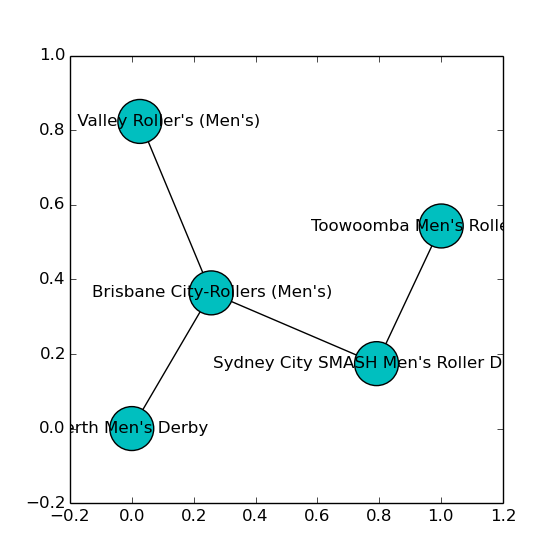
Meanwhile, Women's derby was exploding in Europe, and European teams were increasingly travelling across to the USA to play tougher teams, creating a second pole of derby in the community:
(notice also the first appearance of Yellow in any of our graphs, as Tokyo Roller Girls, Kokeshi Roller Dolls and Devil Dog Derby Dames all make their appearance in the derby scene already integrated into the International scene).
So, fast forwarding to the present day, what does roller derby look like at the start of 2015?
Women's Derby is increasingly truly international, with the dense central cluster of "connected Division 1" type teams being slowly infiltrated by European and Australasian (and a few Latin American) teams drawn in from the edges, although Asia-Pacific derby is still limited to the three Japanese leagues:
Bucking the trend, however, Latin American derby maintains a strong community of its own, disconnected (for the most part) from the rest of the community:
as does the geographically separated Alaskan derby community: Mens' Derby in 2015 looks a lot like Women's Derby did in 2010 or 2011, with a large group of USA/Europe, connected by only a few European mediators:(although Men's derby is a lot more balanced in the sizes of the USA and Europe groups than Women's Derby was in 2010), and a strongly developing and independant Australasian Men's Derby group:
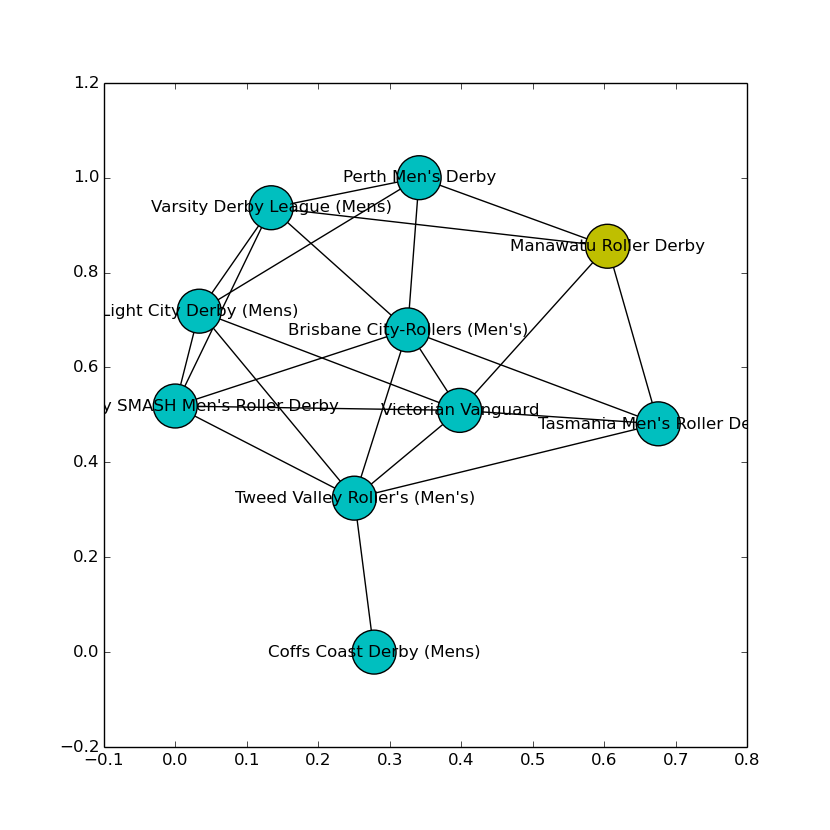
Junior Derby, meanwhile, is still resolutely an American pursuit for the most part:
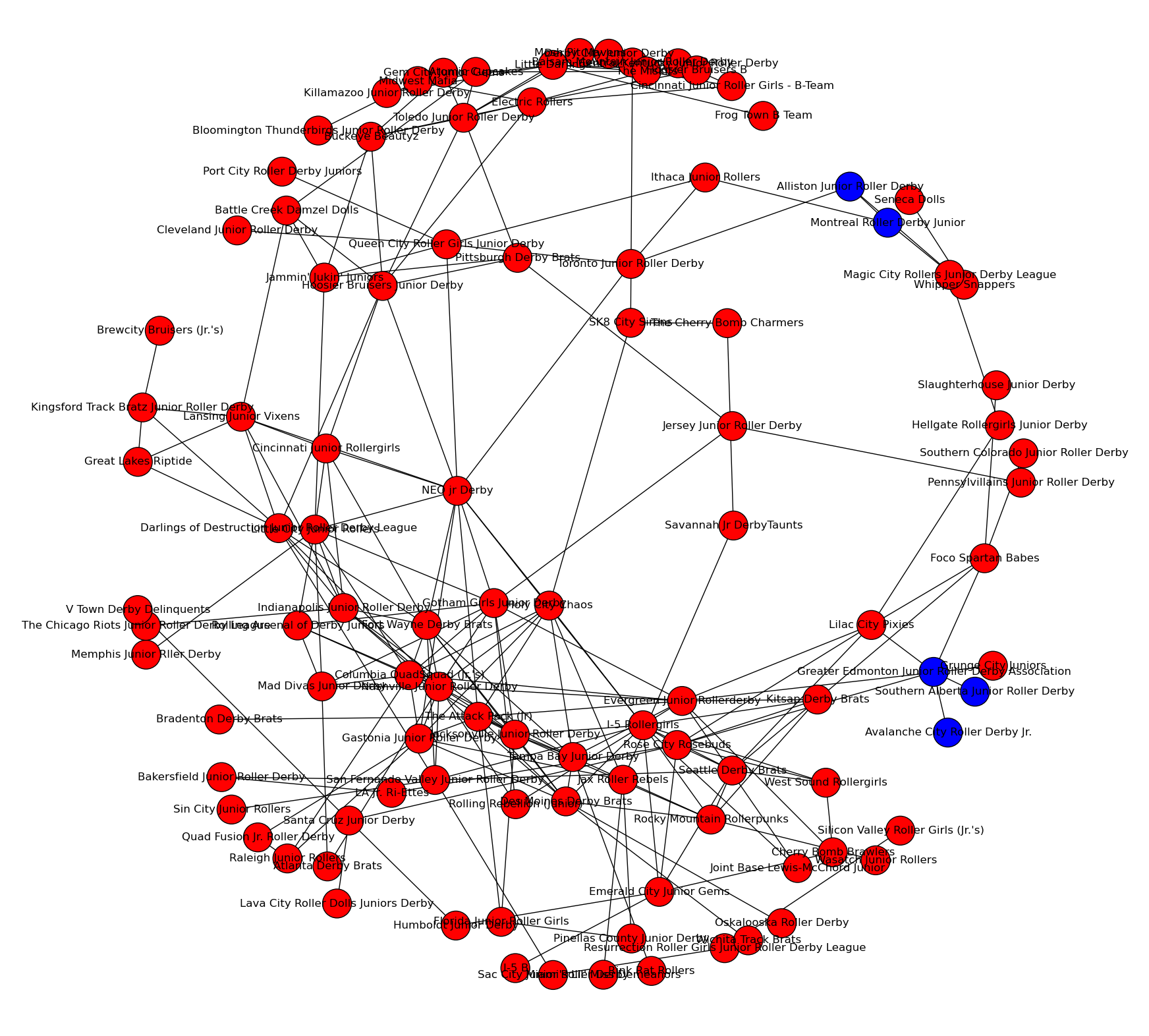 (the few European Junior Derby leagues tend not to have travel teams, or, in Fierce Valley Roller Cubs' case, have no teams with the same age limits to play), although, as with Men's Derby, there's a small Australasian group in evidence as well:
(the few European Junior Derby leagues tend not to have travel teams, or, in Fierce Valley Roller Cubs' case, have no teams with the same age limits to play), although, as with Men's Derby, there's a small Australasian group in evidence as well:
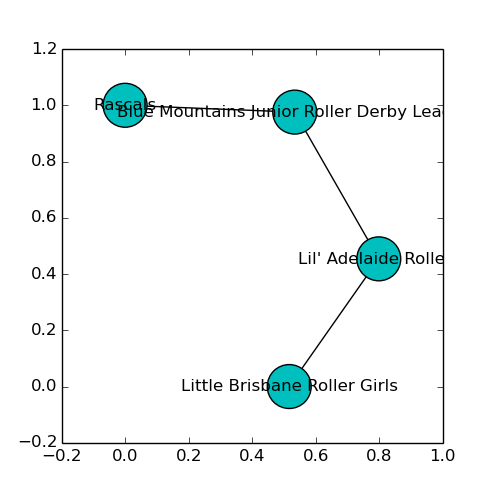
The astute reader will, at this point, be asking why we've not talked about Coed Derby yet. The problem with Coed Derby, based on the FTS records, is that most (WFTDA/MRDA) Coed teams have been Exhibition teams, set up without the formal League structure. As such, they are excluded from the terms in which our plots are constructed: there's literally no bouts on record for formal Coed Travel Teams until 2013!
Interestingly, what Coed Derby there is seems to be following a very different track from the USA-led structures in the rest of the community. The single biggest grouping of Coed Teams in 2013 was entirely Europe (in fact, UK) based:
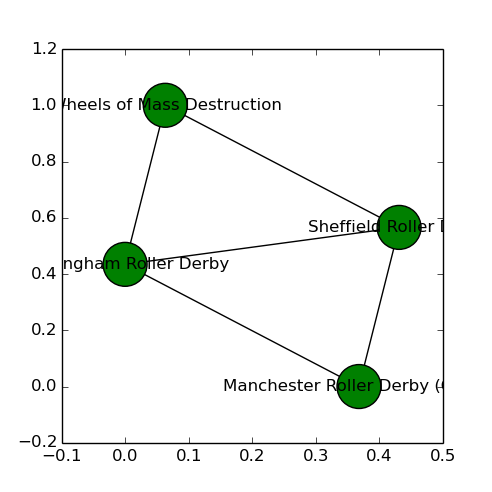
So, what for the future? Well, on the trends we've seen so far, I expect Men's Derby to follow a rather even development, with Australasia joining the International group within the next year, forming a rather well balanced community split three ways in weighting. Women's Derby remains rather unbalanced towards the USA, just because of the delay in derby seeding outside that continent. The evidence suggests that the power imbalance is slowly easing (Glasgow Roller Derby making it into the top 30 WFTDA teams recently, with Stockholm and Helsinki just outside, is a sign of this), but it will probably take several more years before the core derby cluster is noticeably less red than it is now. (We expect it to take about as long for London Rollergirls A to reconnect with the rest of European derby.) The newest region, Asia-Pacific, is something we will cover in a few planned articles to come.
Junior Derby's status outside of the USA is worrying - the evidence from the last year, as several very talented US players have graduated from Junior to Women's derby leagues, suggests that a strong Junior Derby community is very important in the maintenance of a strong Adult community as well. We hope that more will be done in this area across Europe in the coming years.
As for Coed Derby - it's impossibly early to predict. It's possible that the growth of formal teams could be driven entirely from Europe, but as there is no history of this in the sport to date, it is very hard to predict what form its influence could take.
The tools used to generate these plots are available at the author's github repository, along with other statistical tools under development.
Visualising the Internationalisation of Roller Derby (part 1 of 2)
Recently, we've been including some more analytics content on the blog, with included content here and some links from articles to more detailed discussions on the author's personal wordpress. In order to improve our analytics, it's important to have a big set of real world measurements to compare to - you can use these to train your model, and then also to test the new model's predictive power (obviously you use different subsets of your data for training and testing).
Luckily, FlatTrackStats has a very large and complete set of bout records for flat track roller derby, dating back to the very first bouts in 2003. Even more luckily, the FlatTrackStats guys are committed to openness of data, so their records are licensed Creative Commons: Non-Commercial (this means that anyone can use their data for free, as long as they credit FTS, and don't try to profit from whatever they're doing).
In the interests of paying this forward (and because the author also personally believes that it's in the best interests of roller derby to not restrict information unless absolutely necessary), this article and all images therein is licensed Creative Commons: Non-Commercial-ShareAlike (you can reuse this article, and the images therein for anything, as long as you credit me as the source, don't profit from your actions, and share your resulting things under exactly the same license).
Now that we have the FlatTrackStats team and bout databases, up to the last week, we need to process the data in order to make it useful for our model. Part of this processing involves dividing up all of the teams (for any given period of dates) into subsets, such that everyone in a subset has played at least one person in that subset. And if you're doing that kind of processing anyway, you end up writing some tools to visualise the resulting subsets just to check on them... and it turns out that this kind of visualisation is historically interesting in itself.
This article presents the result of some visualisations of the partitions of Flat Track Roller Derby for each year, starting from 2005 (which is really when the first teams solidified from the experimentation in 2003-4). As this data is taken from the FTS bout database, it only includes bouts which teams submitted to FTS (or which were in the DNN derbymatic database, which was also rolled into FTS when DNN closed). We also exclude Exhibition and Home teams from our plots, which mostly has effects for Men's and Coed derby post 2010. Teams are represented by circles, with lines connecting them representing a bout between those teams in the time period covered. The plotting algorithm treats connections like elastic bands, so groups of teams who all played each other are drawn into dense central regions of the plot by the forces between them, while less connected groups are pushed out to the edges.
Looking at 2005, Women's Flat Track Roller Derby was in its infancy. In fact, there are only 9 travel teams known to FlatTrackStats for the period 1 Jan 2005 to 1 Jan 2006, and of course all of them are in the USA. If we partition them into the groups which played each other, we find that there's one "big" group, with 5 members, and 2 small groups with a pair of teams a piece. (It turns out that most of the "isolated" groups we find in any year are 2 or 3 member groups, with teams who are just starting out and only really played one game that year.) The members of the big group are quite familiar today:
(that's Gotham just sliding off the left edge of the graph).
There are no Men's, Junior or Coed teams at this early stage of Flat Track Derby, of course. But Women's Derby is growing rapidly. Moving on to 1 Jan 2006 to 1 Jan 2007, many new teams have started up, mostly in the USA, but with one in Canada. And almost all of them (except one pair of teams) have played at least one other team in the biggest group:
(here we start to see our colour scheme - Red is USA, Blue is Canada, and later on Green will be Europe, Cyan: Australia, Purple: New Zealand, Yellow the Asia-Pacific, and White: South America - drawn from FTS' internal categorisations). This group is really the founding set of the competitive Division 1, and most of them are still there today.But, in 2007, something new happens. There's the continuing explosion of USA derby (the biggest group by far):
But the second biggest group, albeit only three teams, is the beginning of European derby: London Rockin' Rollers, Birmingham Blitz Dames and Stuttgart Valley Rollergirls taking their first steps onto the track: (2007 is also the start of Men's Flat Track Roller Derby, with Harm City playing The Dirty Dozen for the first ever official bout.)By the end of 2008, the European Derby seed is beginning to grow, but they're still entirely separate from the big connected group in the USA. As well as a smattering of teams in the USA and Canada who only played one bout in 2008, there's also the beginning of Cyan on our graphs, with Adelaide Roller Derby playing Victorian Roller Derby League for the first Australian derby on the Flat Track. These are both trends that continue into the end of 2009, with three entirely disconnected centres of Derby developing:
The big USA/Canada (where you can see the tightly linked central bunch of "Division 1" teams continuing to dominate derby):
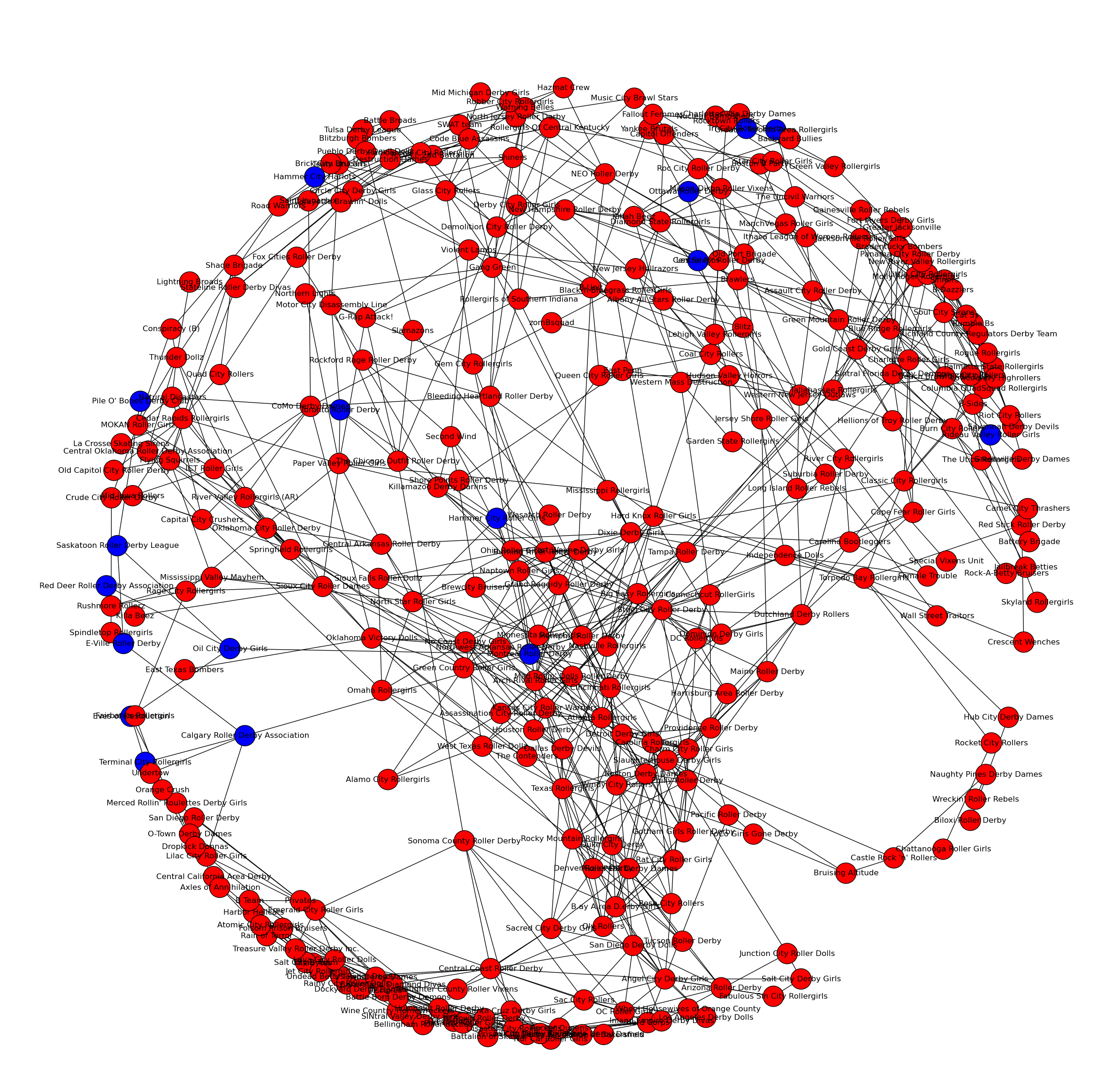
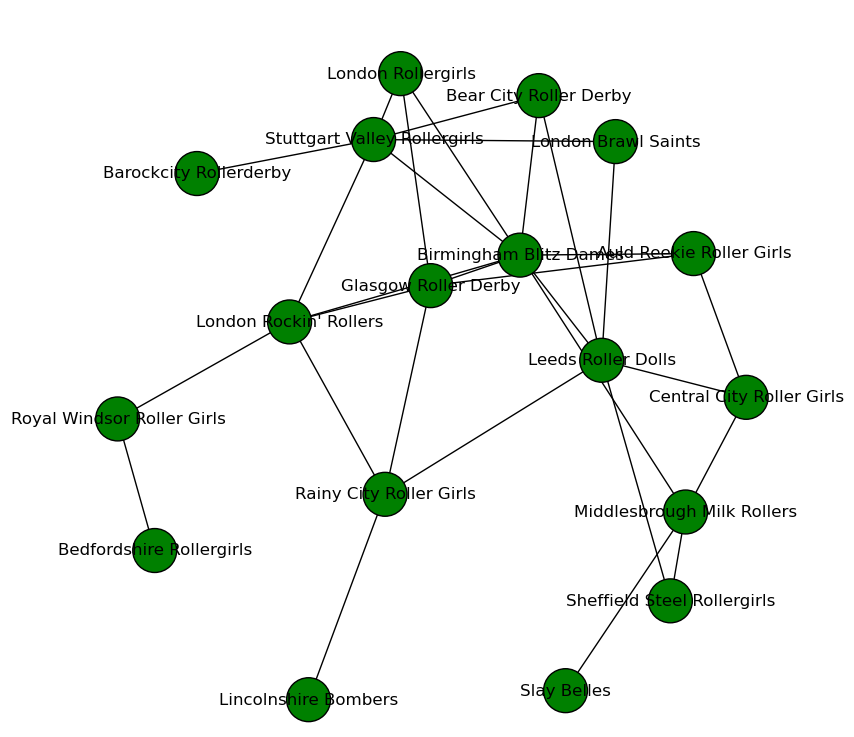
The nascent Australia (so early that we have 6 teams, each of which played only one bout):
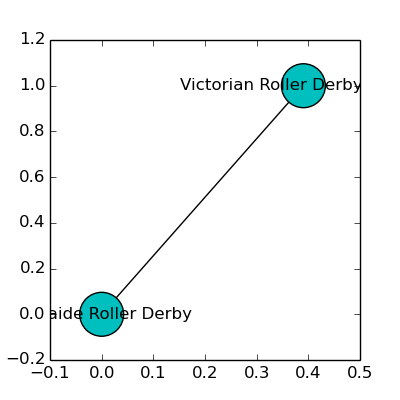 |
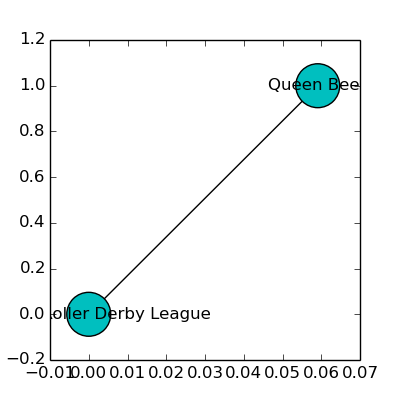 |
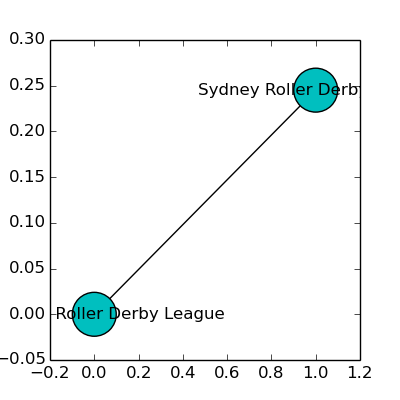 |
Firstly, Europe finally contacts the USA, with London Rollergirls playing their first bouts across the Atlantic. Given the isolation of USA derby from the emerging European and Australasian areas, the ability of London surprises a lot of their opponents (setting a trend for both reactions to London, and reactions to non-US teams in general when visiting the USA).
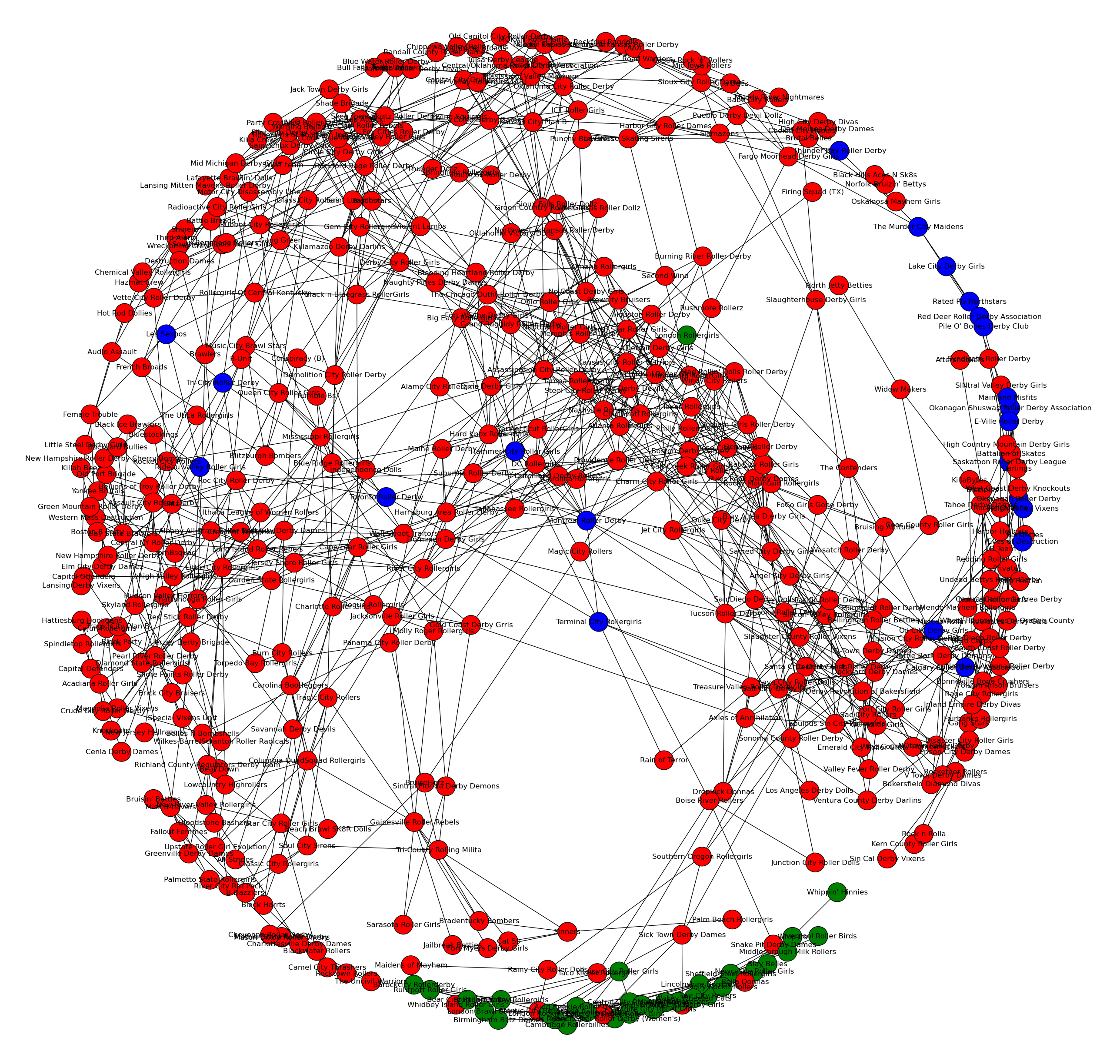 (the Green dot in the middle of the Red central dots is London, while the rest of Europe is relegated to the edge, due to lack of connections to the dense nexus of Important USA Teams). Edit: interestingly, London A is already isolated from Europe by this point - they only played US teams in 2010. It is Rainy City who connect Europe with the USA, having played Oly Rollers B.
(the Green dot in the middle of the Red central dots is London, while the rest of Europe is relegated to the edge, due to lack of connections to the dense nexus of Important USA Teams). Edit: interestingly, London A is already isolated from Europe by this point - they only played US teams in 2010. It is Rainy City who connect Europe with the USA, having played Oly Rollers B.
Secondly, the very first Junior derby starts up (this is Cleveland Firestarters (who were later replaced by Cleveland Junior Roller Derby) v Indianapolis Junior Roller Derby).
Meanwhile, Australasian Derby is still developing apart from the rest of the world. Pirate City Rollers represent the first New Zealand travel team to play others, shown in purple: and a second wave of European derby is beginning, with Gent, Stockholm, Helsinki and others forming a new group of emerging teams, many of which will accelerate into importance both politically and competitively in the next few years: We'll look at the trends in International Derby since the end of 2010 in our second post in this series, where we'll also publish some links to the code used for these plots.Scotland heads the Premier Tier of British Champs!
As of only a few hours ago, the first ever British Champs Premier Tier tournament ended, with the 15th and final bout of the series a surprisingly tight and tense bout between Auld Reekie Roller Girls and Central City Rollergirls. With ARRG emerging victorious, the final placings for the 6 teams in Premier Tier are:
1 Glasgow Roller Derby 2 Auld Reekie Roller Girls 3 Middlesbrough Milk Rollers 4 Tiger Bay Brawlers 5 Central City Rollergirls 6 Rainy City Roller Girls.
Scottish teams therefore take both 1st and 2nd place in the Tier, and CCR and RCRG will unfortunately relegate to the National Tier for the 2016 season.
Hopefully we will have more from Glasgow and Auld Reekie on their placement later. For now, some initial stats are available here.
